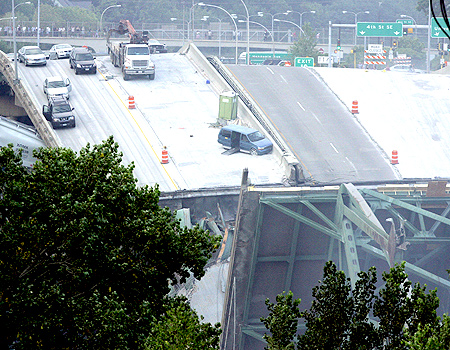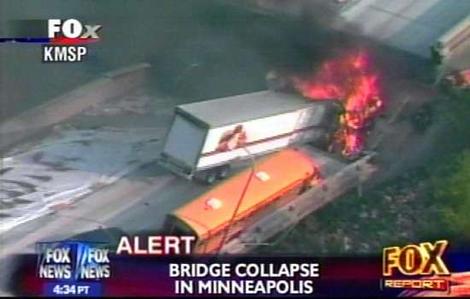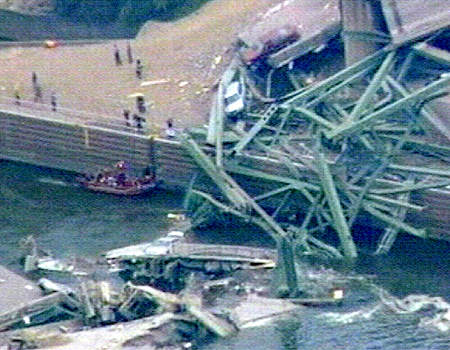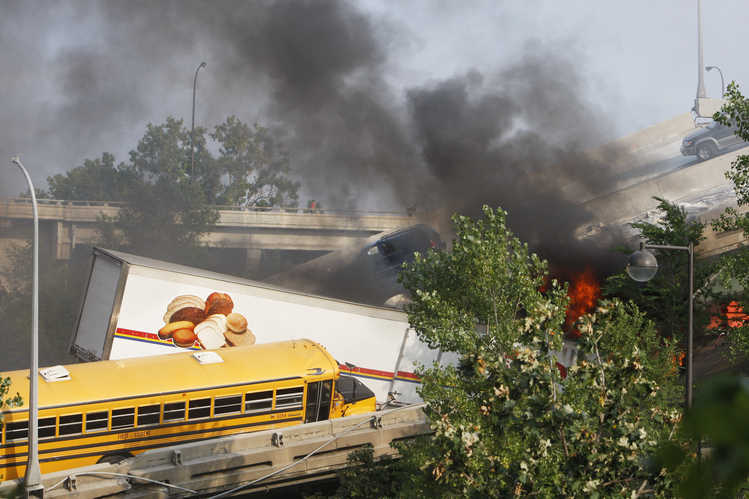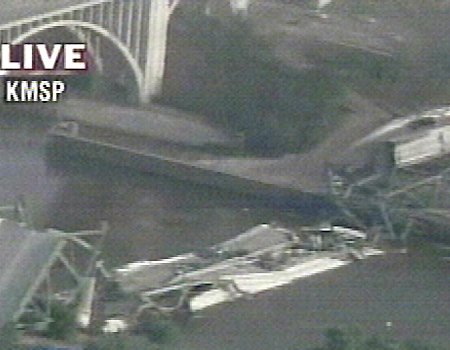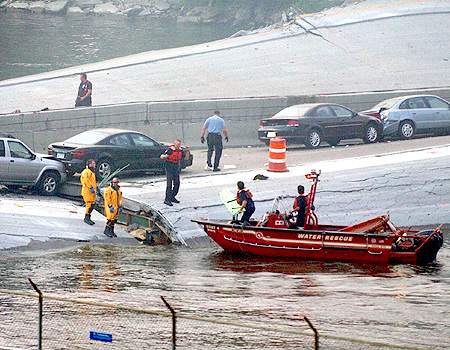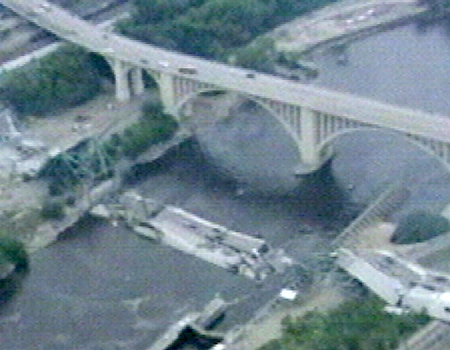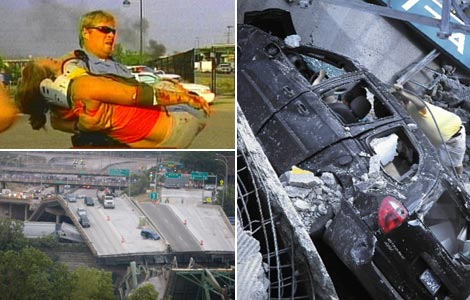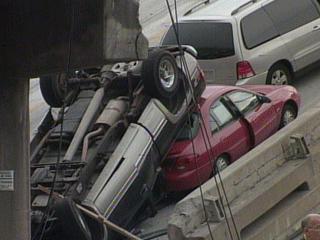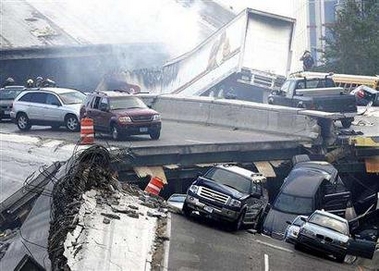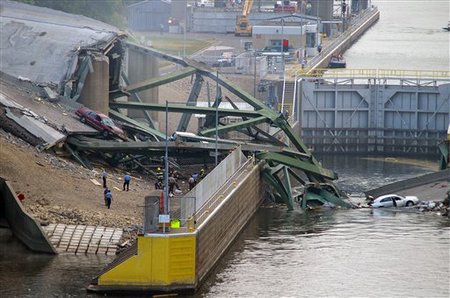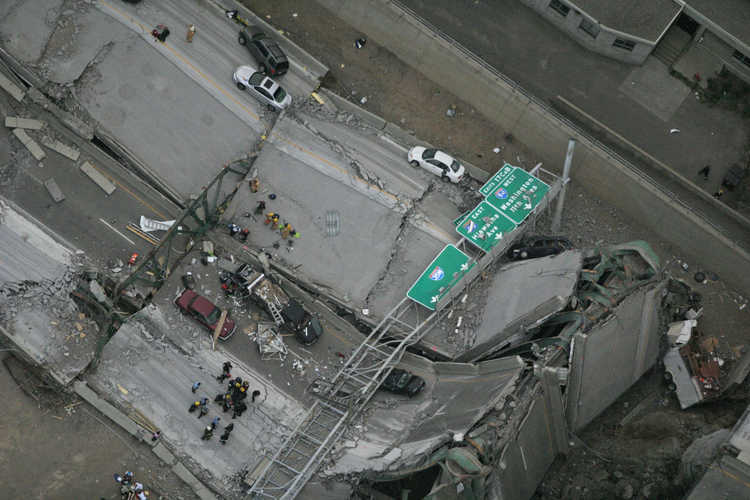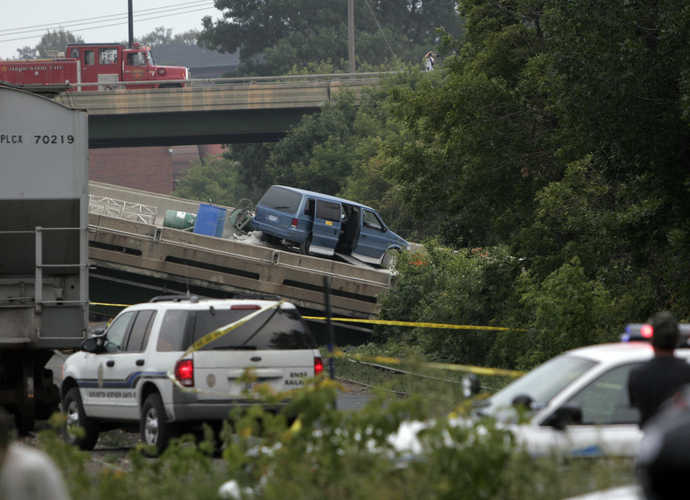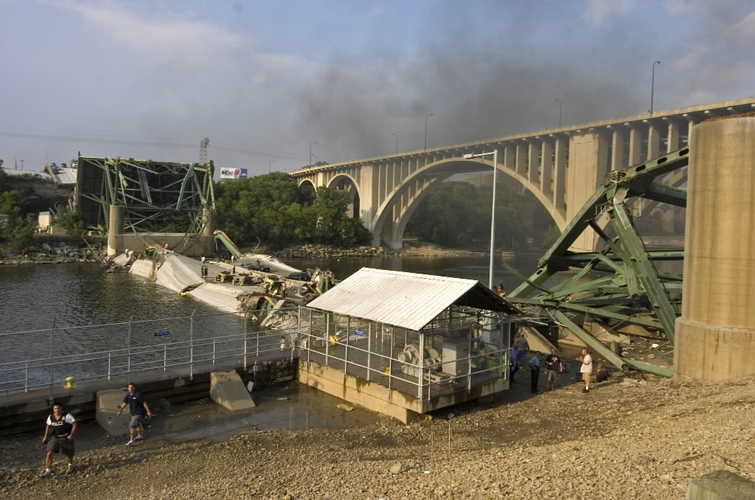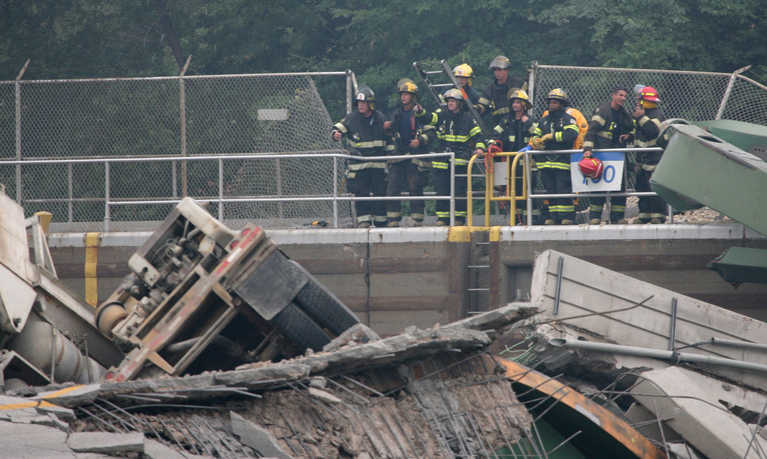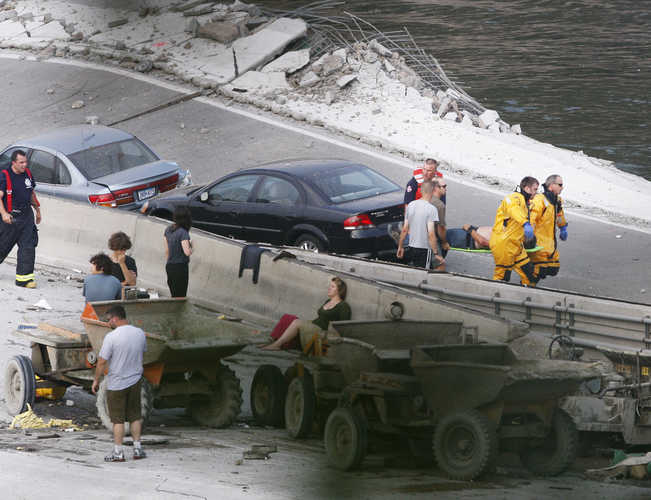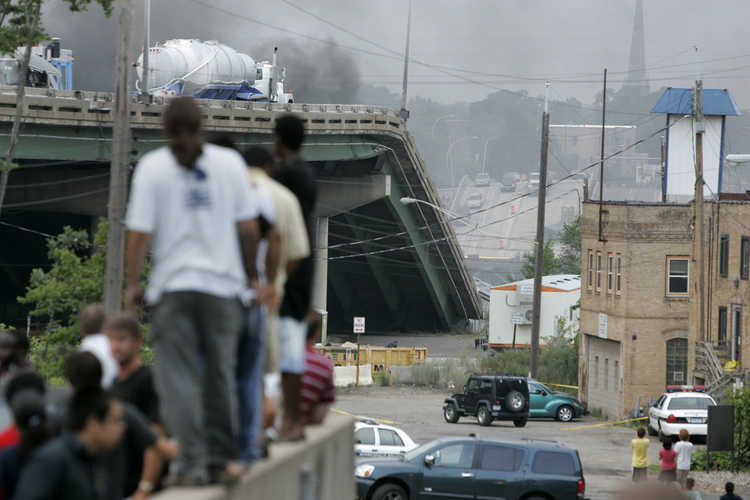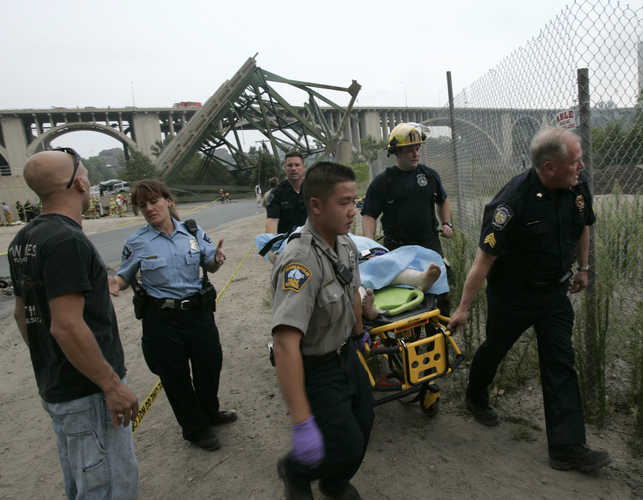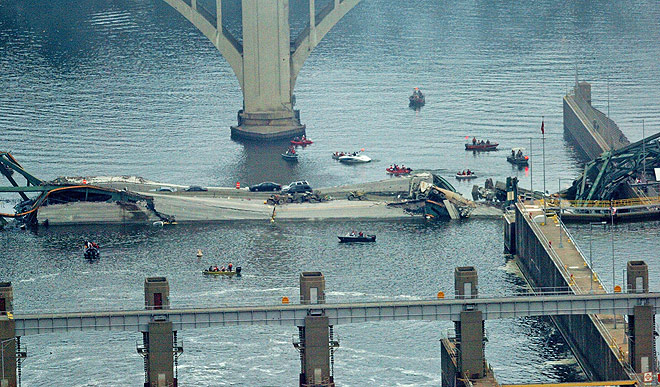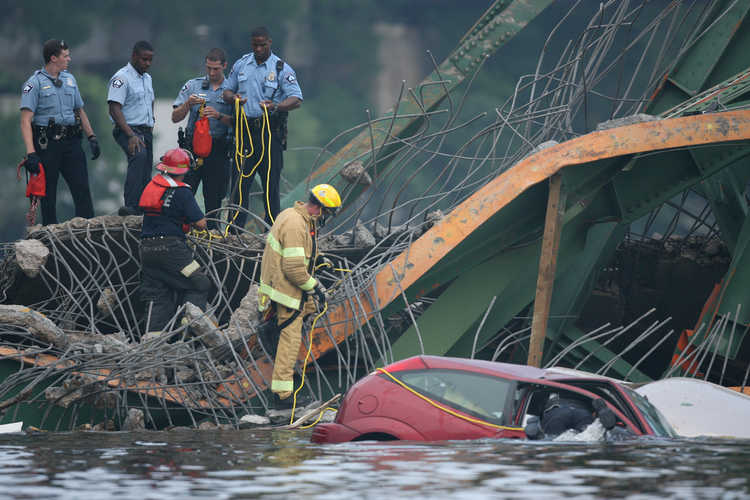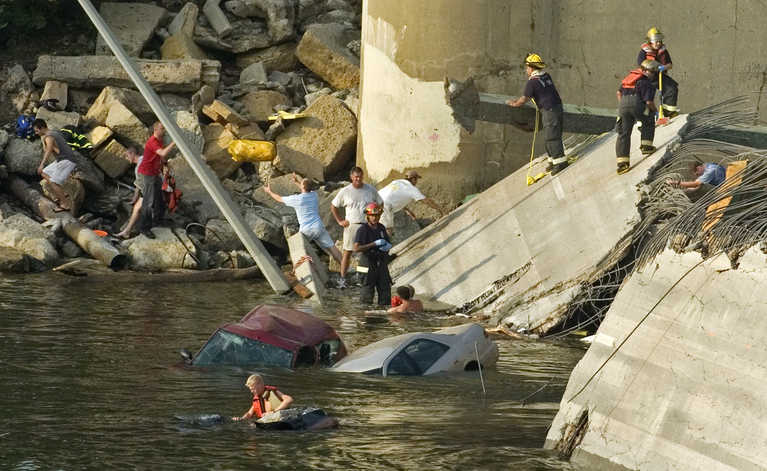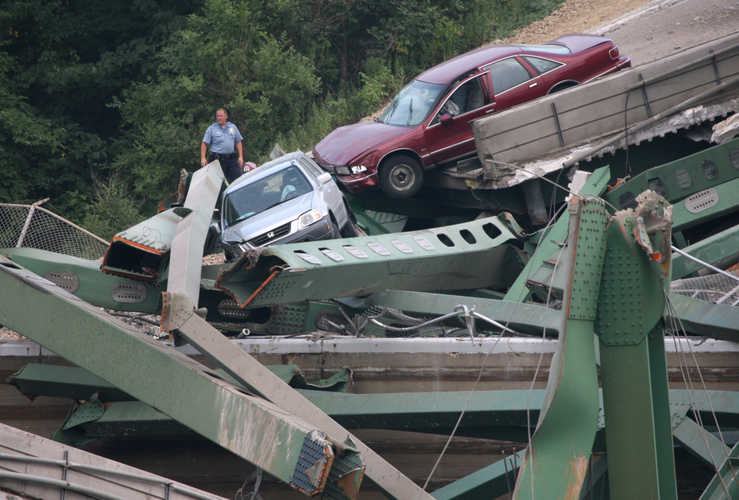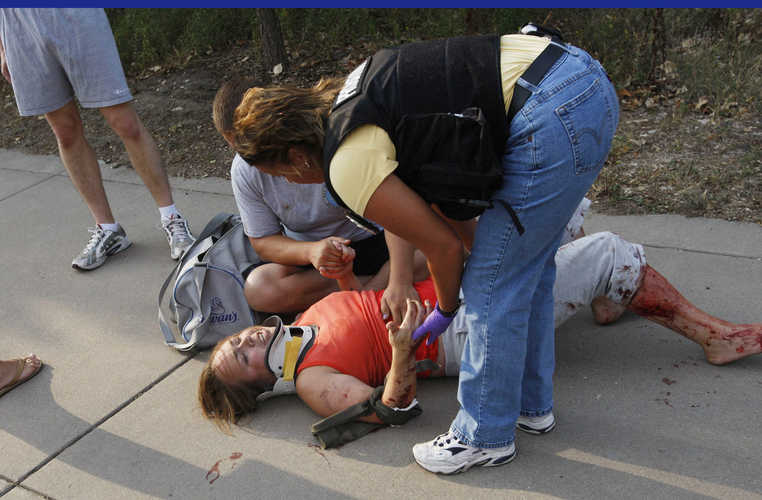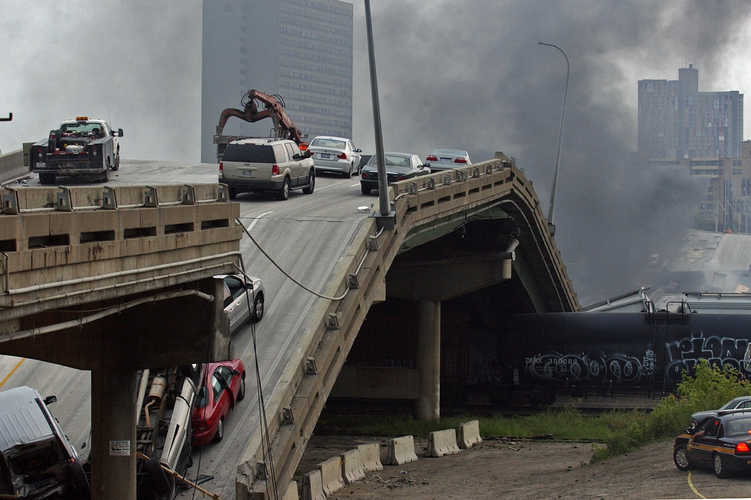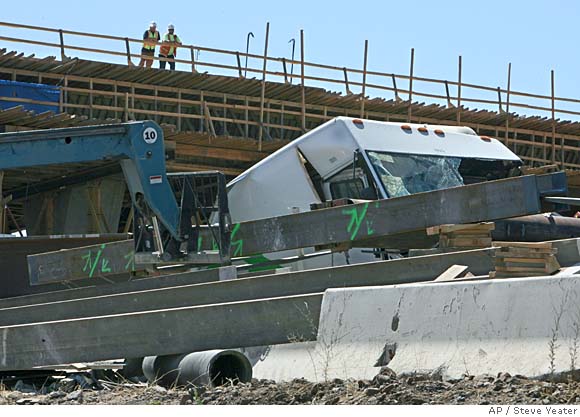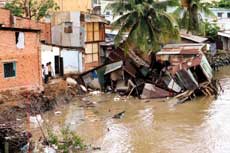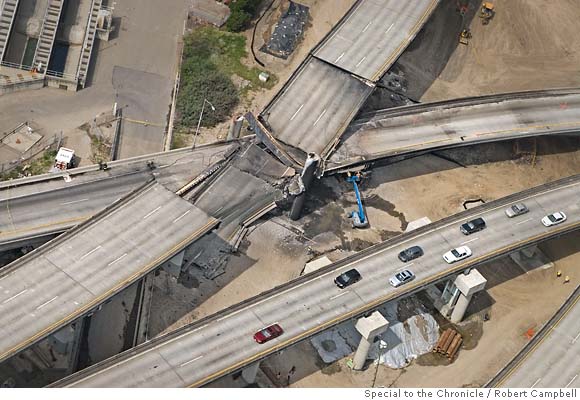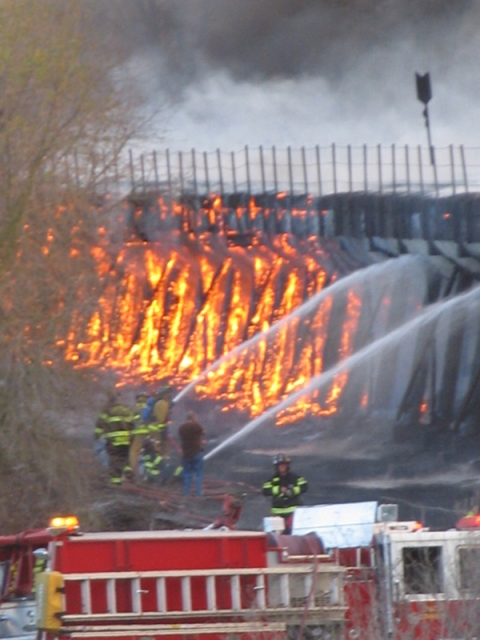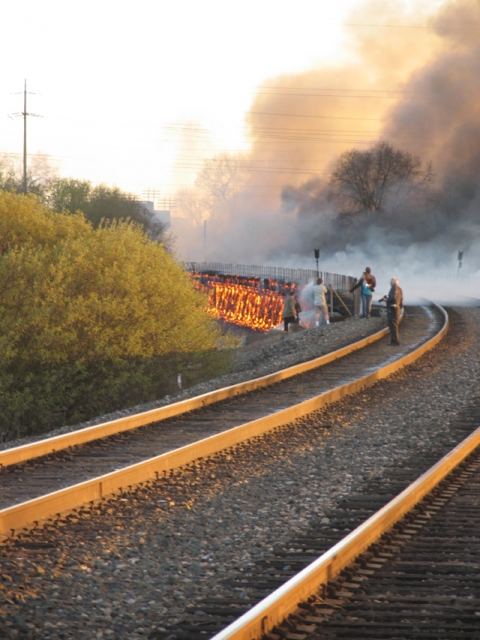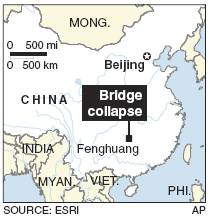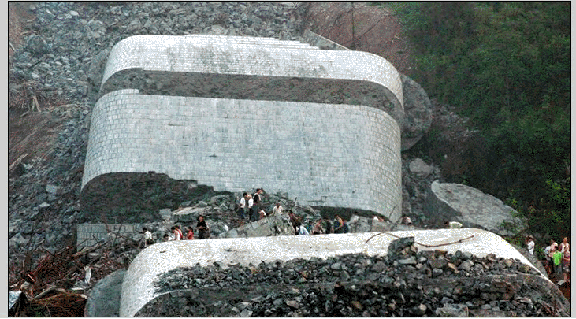Bridge Collapses In Downtown Minneapolis
August 1, 2007
Minneapolis, Minnesota - A major bridge over the Mississippi River in
Minneapolis, Minnesota collapsed this afternoon, dumping at least eight cars
and a truck into the water and land below.
| The center of the Interstate
Hwy. 35W bridge collapsed about 6:05 p.m. with nearly 100 cars on it
during rush hour. A tractor-trailer caught fire, and flame and black
smoke billowed into the sky. Local television stations captured video of
injured people being carried up the riverbank. There was no immediate
word on injuries, but dozens of rescue vehicles were there. Divers were
also in the water.
Cars and people were stranded on parts of the bridge that weren't
completely submerged and some vehicles were on fire.
Workers have been repairing the bridge surface as part of
improvements along that stretch of the Interstate.
Rescue workers were helping some people from cars in the river.
Witnesses at the scene said the entire bridge collapsed, leaving part
of the roadway submerged and part above water.
A number of people were walking around on the roadway that was not
submerged.
"It is just horrific," said witness Marilyn Franzen, who saw the
bridge collapse. Franzen said she saw a school bus that managed to stop
before the going over the edge of the bridge that she said was carrying
20-30 children.
It was not clear how many people might be hurt or killed. NBC News
reported that every Minneapolis ambulance has been requested to the
scene.
© AlaskaReport News
August 2, 2007 - 10:51AM
At least three people are dead after a massive
freeway bridge collapsed into the Mississippi River near Minneapolis
in the US.
Rescue officials told CNN there could be up to 50
to 100 cars in the river.
The bridge, the 35W four-lane state highway which
connects the University of Minnesota with downtown Minneapolis,
collapsed about 6.05pm, during the evening rush hour.
Tons of concrete have collapsed and people are
injured. Survivors are being carried up the riverbank.
Some people are stranded on parts of the bridge
that aren't completely in the water.
Over the past several months the bridge was being
repaired, with workers closing a lane or two at a time.
'I heard a huge roar'
Eyewitnesses said they heard a rumbling sound as
the bridge collapsed into the river. Local media reported 20 to 30
injuries.
"First I heard this huge roar," Leone Carstens, a
nearby resident, told the Minneapolis Star Tribune. "I was at my
computer. Initially I thought, 'Wow was that an airplane?'"
Television pictures showed sections of highway
leading to the bridge had also collapsed, in places crushing cars and
starting fires and trucks.
One witness said she saw people swimming in the
water seeking safety.
Huge chunks of the bridge stuck at odd angles out of the river, in
places surrounded by cars half submerged in the water.
A nursing supervisor at Hennepin county medical
center interviewed by local WCCO radio said: "We have multiple
patients. Some critical, some non-critical," he said. Asked if there
were any deaths, he said: "Not that I know of."
Truck sliced in half
The road was carrying bumper to bumper traffic
when the 500-foot (160 metre) steel arch bridge collapsed. The
bridge, built in 1967, was 64 feet above the river.
The Minnesota Department of Transportation told
local media that 200,000 cars a day use the bridge.
Local media said a school bus taking children
back to the city from a field trip was among the vehicles that were
involved.
Aerial footage of the collapse shows cars and
other vehicles strewn across the collapsed bridge.
At least three sections of the bridge have
collapsed into the river and a fourth section was in danger of
collapse
Cars hung over the edge of the collapsed bridge,
trucks were cut in two or on fire and other vehicles lay precariously
on collapsed sections of the structure.
Paramedics have set up a triage clinic near the
scene and at least 20 people have been taken to local hospitals.
There is no reason to think the collapse of a
freeway bridge in Minneapolis was terror-related, the Department of
Homeland Security said.
Agencies
~~~~
Jano Gibson, Dylan Welch and wires
August 2, 2007 - 12:07PM
Do you know more? Message 0424 SMS SMH (+61 424 767
764) or
email us with information or images.
Six people have been confirmed dead in the
collapse of a bridge over the Mississippi River in the US city
of Minneapolis, Minnesota Mayor R.T. Rybak says.
"We have confirmed six deaths and we are continuing the
search," Mr Rybak said at a press conference.
"At this point, we have searched approximately 50 cars ... we
have confirmed that this will be a very tragic night when it
is over."
Huge chunks of the bridge stuck at odd angles out of the
river, in places surrounded by cars half submerged in the
water.
The road was carrying bumper-to-bumper
traffic when the 160-metre steel arch bridge collapsed. The
bridge, built in 1967, was about 20 metres above the river.
The Minnesota Department of
Transportation told local media that 200,000 cars a day use
the bridge.
A truck driver told the Star Tribune
he was driving about 16kmh in bumper-to-bumper traffic when
the roadway fell away in front of him.
"I fell probably about 30 or 40 feet,
landed on the [inaudible] of the Mississippi. I'm so lucky to
be alive," the unnamed man said.
"On the way down I thought I was dead. I
literally thought I was dead. My truck was completely face
down, was pointing towards the ground, falling towards the
ground.
"My truck ripped in half. When I got out
of my truck it was folded in half. I can't believe I am
alive."
He said his seatbelt was the reason he
was alive.
"I had my seatbelt on and if I didn't I
probably would have went through the windshield. I only have a
cut on my face from the steering wheel.
"I saw a tanker go head first into the
water. There was only about five feet at the back end showing
out of the water."
He said he helped carry young children
and teenagers who had been in a school bus off the bridge.
According to CNN, a police officer told a
witness that he had seen at least seven people dead at the
scene. Rescue officials told CNN there could be up to 50 to
100 cars in the river.
Joseph Clinton, a doctor from Hennepin
County Medical Centre told a press conference that his
hospital had admitted 29 people as a result of the bridge
collapse.
"We're telling people who were in the
waiting room that if they weren't critically injured to come
back later," he said.
One person admitted had died, believed to be
from drowning, he said.
Twenty-two others were seriously injured and a further six
were critically injured, he said.
Tonnes of concrete on the bridge have
collapsed. Survivors were seen being carried up the riverbank.
The US Department of Homeland Security in
Washington said there was no indication of terrorism in the
disaster.
"There is no indication of a nexus to
terrorism at this time," department spokesman Russ Knocke
said.
The entire span of the 35W bridge
collapsed about 6.05pm [US time] where the freeway crosses the
river near University Avenue.
Some people were stranded on parts of the
bridge that were not completely in the water.
A large truck was on fire at the collapse
scene.
Earlier, local reports said at least 20
cars had gone into the water from the crowded peak hour
traffic.
Eyewitness accounts
"I saw them carrying up a body - I don't
know if he was alive or dead,'' said Andy Schwich, who arrived
at the scene on his bicycle a few minutes after the collapse.
A truck was exploding in fireballs, he
said, and there were numerous cars either on the remnants of
the bridge or in the river.
"It was the worst thing I ever saw," Mr
Schwich, 29, said.
The Star Tribune quoted a
witness, Ramon Houge, saying he heard a rumbling sound as he
was driving across the bridge.
He saw the ground collapse and cars go
down.
Other cars backed up as best they could,
he said.
He was able to park in a construction
zone and eventually drive off the bridge.
"It didn't seem like it was real," he
told the paper.
He said he saw children on a bus with
blood on their faces.
A nearby resident added: "First I heard
this huge roar. I was at my computer. Initially I thought, Wow
was that an airplane?''
Television pictures showed sections of
highway leading to the bridge had also collapsed, in places
crushing cars and starting fires.
One witness said she saw people swimming
in the water seeking safety.
Local media said a school bus taking
children back to the city from a field trip was among the
vehicles that were involved.
Witnesses told Fox News the bridge
started shaking and went down fast.
At least three sections of the bridge had
collapsed into the river and a fourth section was in danger of
collapse, reports said.
Photographs taken from an apartment
overlooking the bridge in Minneapolis, Minnesota shown on CNN
showed a disastrous scene of people crouching on bent and
crumpled concrete with parts of the bridge submerged in the
brown river.
Rescue workers scrambled into the river
gorge to help people off the huge chunks of concrete roadway
as fire and smoke rose from the wreckage, the Star Tribune
reported.Bridge
undergoing repairs
According to reports, the 40-year-old
bridge was undergoing repairs at the time of the accident, and
there were reports that construction workers were using a
jackhammer at the time of the collapse.
Reports say that the bridge was inspected
three years ago and given a clean bill of health.
Sarah Fahnhorst, who lives in an
apartment a block away from the bridge, heard a huge thud and
then "the entire building shook. It shook the ground''.
Gregory Wernick snr drove over the bridge
shortly before the collapse.
He stopped to get a drink nearby and
heard commotion so he went back.
"I figure I crossed about 10 minutes
before it happened," he said. "That's just too close to call."
He was standing about 60 metres away on
top of a parking ramp with a large group of people.
"I've never seen anything like this," he
said.
- with agencies
Survivors
Recount Escape From Bridge
By JON KRAWCZYNSKI
08.01.07, 11:07 PM ET
MINNEAPOLIS -
Some dropped with the collapsing
bridge into the waters of the Mississippi River and swam
to safety, while others leaped from their cars over
yawning gaps of asphalt to solid ground.
Survivors and witnesses cried and
hugged each other as rescue crews tried to save who they
could and gauge the scope of the catastrophic collapse
of the eight-lane bridge. At least six people died.
Dennis Winegar of Houston, Texas,
said he felt the Interstate 35W bridge start to shake.
"I slammed on my brakes and saw something in front of me
disappear and then my car pointed straight down and we
fell." He estimated they dropped about 50 feet.
"I just reacted, put my foot on the
brakes and started praying we didn't flip over," he
said. "When I got out ... there was a car lodged
underneath me and one right next to me."
His wife, Jamie Winegar, said
everyone around them got out of their cars and tried to
help each other off the bridge. "There were a bunch of
people right around there helping everyone. Angels is
what I call them."
Peter Siddons was on his commute
home north when he heard "crunching" and saw the bridge
start to roll and then crumple, he told the Star
Tribune. "It kept collapsing, down, down, down until it
got to me."
His car dropped with the bridge but
stopped when his car rolled into the car in front of
him. He got out of his car, jumped over the crevice
between the highway lanes and crawled up the steeply
tilted section of broken bridge and jumped to the
ground.
"I thought I was dead," said the
senior vice president at Wells Fargo Home Mortgage.
"Honestly, I honestly did. I thought it was over."
Caught on the span was a school bus
filled with children on their way back from a day of
swimming, said Ryan Watkins, one of the children. He
said the bus bounced twice and stopped, its front door
wedged against a concrete traffic barrier. They fled
through the rear door.
A truck driver from Georgia,
Charles Flowers, saw the collapse from banks of the
river. Instantly, the water was filled with floating
cars and people - injured, dazed - asking for help, he
said.
He and several others ran down the
riverbank and he pulled a woman from the water. He said
he thought she did not survive. "I never thought I'd see
anything like this," he told the newspaper.
Catherine Yankelevich survived the
1994 earthquake in Northridge, Calif., and was on the
I-35W bridge when it began to shake. "Cars started
flying and I was falling and saw the water," she said.
Her car wound up in the river so she climbed out the
driver's side window and swam to shore uninjured.
"It seemed like a movie, it was
pretty scary," said Yankelevich. "I never expected
anything like this to happen here."
Copyright 2007 Associated Press.
All rights reserved.
|
Survivors, rescuers reflect on catastrophe
August 1, 2007
By Kevin Giles and Richard Meryhew
(Minneapolis) Star Tribune
MINNEAPOLIS
It looked as though an earthquake had hit.
From across the Twin Cities and from small towns
beyond, rescue workers, doctors, nurses and
construction workers flooded into downtown
Minneapolis early tonight, making their way past
Twins fans at the Metrodome, past thousands of
gawkers aiming their cell phone cameras at the
crumpled steel frame and a bridge deck sliced into
three pieces.
At 6:45 p.m. local time, more than a half-hour after
disaster struck, police yelled at the onlookers to
get back, off the north section of the bridge where
rescue workers below searched for survivors. They
feared that section could still collapse on them.
Rescue crews from North St. Paul, Vadnais Heights
and Maplewood blared their sirens, creeping through
the crowd of onlookers. But once inside the ring of
pandemonium, this catastrophe became an orderly
scene of grim determination and efficiency.
Ambulances queued up, police escorting them
one-by-one down into the bridge area. The rescue
teams had rehearsed for this kind of catastrophe.
There was little shouting, no chaos. A state command
center was quickly opened to coordinate the rescue.
“It looked like a terrorist attack, a complete
catastrophe,” said impromptu rescuer Ryan Murphey,
30, of Minneapolis. “But everyone there was very
calm and organized.”
Water cannons shot streams at smoldering vehicles.
The walking wounded, necks in braces, were guided
off the bridge and out of the area.
Overhead and across the river valley, the sound of
television helicopters and sirens cut through the
hot breeze. Rescue workers gingerly crept onto the
bridge, peering over cracked bridge sections looking
for survivors in the cars and trucks half-submerged
in the gray water of the Mississippi rippling
against this unexpected obstacle to its path south.
To the west, an ominous sky dropped cloud-to-ground
lightning and dime-size hail, threatening to make
the already horrific rescue scene even more
dangerous for workers
Across the Twin Cities, stunned families stared at
their televisions. Frantic calls to relatives
driving home in the tail-end of rush hour added to
the crush of emergency calls and cell phone circuits
jammed.
Melissa Hughes of Minneapolis was the driver of one
of six cars under the north end of the bridge.
“It seemed like people and things were in the air
that weren’t supposed to be there,” she said.
Four drivers and a 12-year-old boy were huddled
nearby, their cars in the water where they had slid
as the north end collapsed.
Boats pulled by emergency vehicles moved in quickly.
Nearby, a bridge immediately east of the collapsed
bridge was filled with emergency vehicles. A crane
was on one section of the bridge, too, attempting to
remove concrete barriers.
In office buildings on the riverbank near the
University of Minnesota, office workers felt the
collapsed and rushed to their windows.
“I thought an airplane flew too low over our
building. It just shook,” said Danielle Behling of
St. Paul. University students ran to the river.
Stephanie Bakkum was making dinner when she heard a
“huge explosion.” She and some friends rushed to the
site just as survivors began crawling up from the
collapsed freeway section.
Within seconds, another loud explosion shook the
ground as a tanker blew up.
As emergency crews worked, shaken bystanders stared.
Many said they had driven across the bridge minutes
before it collapsed.
One was Ken Savage, who drove an empty dump truck
across the bridge half an hour before it collapsed.
He said every time he drove across the bridge, with
all the construction going on, he wondered what
would happen if he was loaded with topsoil.
Joe Hughes, 18, of Lake Elmo was helping someone
move nearby when he heard the noise. He and a
friend, Jared Powers, 18, of Mahtomedi ran to the
bridge to help carry stretchers. They saw crushed
cars, a burning school bus and cars floating in the
water.
He said the people they carried out were mostly
silent or unconscious, except for the last man.
“He wanted to call his fiancee,” said Hughes.
(c) 2007, Star Tribune (Minneapolis)
Distributed by McClatchy-Tribune Information
Services.
Hopes Dim in Minneapolis for Survivors
Aug
2, 9:01 AM (ET)
By JON KRAWCZYNSKI
MINNEAPOLIS (AP) - Divers
searched the Mississippi River
for bodies Thursday among the
submerged cars and twisted
steel left by deadly
interstate bridge collapse,
their hopes of finding
survivors having dimmed.
"This is not a rescue
operation any longer," said
Chief Jim Clack of the
Minneapolis Fire Department.
"It's a recovery operation,
which means we move slower and
more deliberately."
Authorities lowered the
death toll to four, but warned
the final number could change
as divers comb the wreckage
for as many as 30 people still
missing.
Police Lt. Amelia
Huffman said: "This morning,
the medical examiner's office
only has four sets of
remains." Initial reports of
seven people killed were based
on the best estimates
authorities had Wednesday
night, she said.
The eight-lane
Interstate 35W
bridge, a major
Minneapolis
artery, was in the
midst of being
repaired and two
lanes in each
direction were
closed when the
bridge buckled
during evening
rush hour
Wednesday, sending
dozens of cars
plummeting more
than 60 feet into
the Mississippi
River.
Authorities
were checking
license numbers of
the cars in the
water. Getting the
vehicles out of
the water will
involve moving
around very large,
heavy pieces of
bridge.
"The bridge
is still
shifting," said
Minneapolis Police
Chief Tim Dolan.
"We're dealing
with the
Mississippi River.
We're dealing with
currents. We're
going to have to
do it slowly and
safely."
Relatives of
some of the
missing gathered
in a hotel
ballroom early
Thursday, waiting
for word on loved
ones who couldn't
be located.
"I've never
wanted to see my
brother so much in
my life," said
Kristi Foster, who
went to an
information center
set up at a
Holiday Inn
looking for her
brother Kirk. She
hadn't had contact
with her brother
or his girlfriend,
Krystle Webb,
since the previous
night.
More than 60
people were
injured and as
many as 50
vehicles were in
the river, many of
their occupants
having scrambled
to shore. The
collapse did not
appear to be
terrorism-related.
Some injured
people were
carried up the
riverbank, while
emergency workers
tended to others
on the ground and
some jumped into
the water to look
for survivors.
Fire and black
smoke rose from
the wreckage.
Gov. Tim
Pawlenty said the
bridge was
inspected by the
Minnesota
Department of
Transportation in
2005 and 2006 and
that no immediate
structural
problems were
noted. "There were
some minor things
that needed
attention," he
said.
"They
notified us from
an engineering
standpoint the
deck might need to
be rehabilitated
or replaced in
2020 or beyond,"
Pawlenty said
Wednesday.
The
40-year-old bridge
was rated as
"structurally
deficient" two
years ago and
possibly in need
of replacement,
the Star Tribune
reported. The
newspaper said
that rating was
contained in the
U.S. Department of
Transportation's
National Bridge
Inventory
database.
"We've seen it,
and we are very
familiar with it,"
Jeanne Aamodt, a
spokeswoman for
the Minnesota
Department of
Transportation,
said of the 2005
assessment of the
bridge.
Aamodt noted
that many other
bridges around the
country carry the
same designation
that the I-35W
bridge received.
She declined to
say what the
agency was going
to do to address
the deficiencies
found in 2005.
Road crews
were working on
the bridge's
joints, guardrails
and lights this
week, with lane
closures overnight
on Tuesday and
Wednesday. The
bridge was fitted
in 2001 with a
computerized
anti-icing system
that sprayed
chemicals on the
surface during
winter weather,
according to
documents posted
on the Minnesota
Department of
Transportation's
Web site.
There were
18 construction
workers on the
bridge at the time
of the collapse,
said Tom Sloan,
head of the bridge
division for
Progressive
Contractors Inc.,
in St. Michael.
One of the workers
was unaccounted
for.
Sloan said
his crew was
placing concrete
finish on the
bridge for what he
called a routine
resurfacing
project. "It was
the final item on
this phase of the
project. Suddenly
the bridge gave
way," he said.
Sloan said his
workers described
a horrific scene.
"They said they
basically rode the
bridge down to the
water. They were
sliding into cars
and cars were
sliding into
them," he said.
The entire
span of Interstate
35W crumpled into
the river below.
Some injured
people were
carried up the
riverbank, while
emergency workers
tended to others
on the ground.
A school bus
had crossed the
bridge before it
collapsed. The bus
did not go into
the water, and
broadcast reports
indicated the
children on the
bus exited out the
back door.
Christine
Swift's
10-year-old
daughter, Kaleigh,
was on the bus,
returning from a
field trip to
Bunker Hills in
Blaine. She said
her daughter
called her about
6:10 p.m.
"She was
screaming, 'The
bridge
collapsed,'" Swift
said. All the kids
got off the bus
safely, but about
10 of the children
were injured,
officials said.
Sen. Norm
Coleman, R-Minn.,
said he spoke with
Transportation
Secretary Mary
Peters, and that
both of them along
with Sen. Amy
Klobuchar, D-Minn.,
will be flying to
the Twin Cities
early Thursday.
The
collapsed bridge
stood just blocks
from the heart of
Minneapolis, near
tourist
attractions like
the new Guthrie
Theater and the
Stone Arch Bridge.
As the steamy
night progressed
massive crowds of
onlookers
circulated in the
area on foot or
bicycle, some of
them wearing Twins
T-shirts and caps
after departing
Wednesday night's
game at the nearby
Metrodome early.
Thursday's
game between the
Twins and Kansas
City Royals was
called off, but
the Twins decided
to go ahead with
Wednesday's rather
than sending about
25,000 fans back
out onto the
congested
highways. Inside
the stadium, there
was a moment of
silence to honor
victims.
The
steel-arched
bridge, which was
built in 1967,
rose about 64 feet
above the river
and stretched
about 1,900 feet
across the water.
The bridge was
built with a
single
458-foot-long
steel arch to
avoid putting any
piers in the water
that might
interfere with
river navigation.
The river's
depth at the
bridge was not
immediately
available, but the
U.S. Army Corps of
Engineers
maintains a
channel depth of
at least 9 feet in
the Upper
Mississippi from
Minneapolis
southward to allow
for barge and
other river
traffic. The site
is just downstream
from the St.
Anthony Falls
locks and dams.
---
Associated
Press Writers
Brian Bakst and
Patrick Condon
contributed to
this report from
Minneapolis;
Martiga Lohn
contributed to
this report from
St. Paul.
++
MINNEAPOLIS,
Minnesota
(CNN)
--
As
many
as
50
vehicles
are
trapped
in
the
rubble
of
an
interstate
bridge
collapse,
and
officials
said
Thursday
it
could
take
five
days
or
longer
to
search
the
wreckage.
Four people were confirmed dead, and officials said at least 79 people were injured when the Interstate 35W bridge over the Mississippi River collapsed during the Wednesday evening rush-hour in Minneapolis.Twenty to 30 people were missing, Minneapolis police Chief Tim Dolan said Thursday. Thirty to 50 cars remain in the river, the U.S. Coast Guard said.
The water below the collapsed bridge is about 7 to 8 feet deep -- just covering the roofs of the dozens of cars that remain in the water, Dolan said.
The eight-lane bridge fell 60 feet, about six stories, into the river.
"This is going to take a long time, this recovery," Dolan said.
Hennepin County Sheriff Richard Stanek said conditions in the Mississippi River were treacherous, as the twisted steel and blocks of pavement were pushed around by river currents. He said the search could go on for five days or longer.The Hennepin County medical examiner on Thursday morning said the confirmed death toll was four, lower than the seven to nine deaths reported earlier.
But Dolan said there were more bodies to be recovered.
"We have a number of vehicles that are underneath big pieces of concrete, and we do know we have some people in those vehicles," The Associated Press quoted Dolan as saying. "We know we do have more casualties at the scene."
President Bush on Thursday pledged federal aid to rebuild the bridge.
Security camera video showed the Interstate 35W bridge's center section collapsing into the river in less than four seconds. The northern end of the span appeared to drop first and the southern end followed.
CNN obtained the video from a source who asked to remain unidentified because they were not authorized to distribute it publicly.  Watch bridge collapse video » Watch bridge collapse video »
Gary Babineau was driving his truck across the bridge as it fell.
"I could see the whole bridge as it was going down and as I was falling, and it just gave a rumble real quick, and it all just gave way, and it just fell completely all the way to the ground," Babineau said. See photos of the disaster »
"This particular section or freeway was under repair," Minneapolis fire Chief Jim Clack said. "We don't know yet what caused the collapse. We do not believe at this point there was any terrorism or nefarious activity -- it was just a structural collapse."
A federal investigative team has been dispatched to the scene.
A school bus filled with more than 50 children who were returning from a summer field trip was among the vehicles on the bridge when it collapsed.
Kristy Jenkins credits staff member Jeremy Hernandez with saving her 12-year-old daughter, Nina Jenkins.
Hernandez "busted open the backdoor of the bus" and "told everyone to get out from the back of the door," the girl said. "We jumped on the highway and then jumped on the sidewalk."
"If it would have been a second later, any second before we would have been in the water or under the pavement," he said.
Tony Wagner, the president of a local nonprofit social services group that organized the trip, said eight of the kids, ages 5 to 14, were hospitalized.
More Information
How you can help: American Red Cross
Mark Lacroix, who lives on the 20th floor of an apartment building near the bridge, told CNN he saw the last seconds of the collapse.
"I heard this massive rumbling and shaking ... and looked out my window," Lacroix said. "It just fell right into the river."  Watch Lacroix describe the collapse » Watch Lacroix describe the collapse »
According to the Minneapolis Riverfront District Web site, the steel arch bridge was opened in 1967. Its longest span stretches 458 feet over the river, and it was constructed with no mid-river piers to facilitate river traffic.
The bridge was undergoing nonstructural re-decking work, U.S. Transportation Department spokesman Brian Turmail said.
There were eight construction workers on the bridge at the time of the collapse, and one of them is unaccounted for, said Mike McGray, president of Progressive Contractors, the company doing the repair work on the bridge.
A 2001 study conducted by the Minnesota Department of Transportation found "several fatigue problems" in the bridge's approach spans and "poor fatigue details" on the main truss.
The study suggested that the design of bridge's main truss could cause a collapse if one of two support planes were to become cracked, although it allowed that a collapse might not occur in that event. But, the study concluded, "fatigue cracking of the deck truss is not likely" and "replacement of the bridge ... may be deferred."
Two years ago, the U.S. Department of Transportation's National Bridge Inventory database said the bridge was "structurally deficient."
The Minneapolis Star Tribune quoted Jeanne Aamodt, a spokeswoman for the Minnesota Department of Transportation, as saying the department was aware of the 2005 assessment of the bridge.
The bridge received a rating of 4 on a scale of 1 to 10. A bridge receives a rating of 4 when there is "advanced section loss, deterioration."About 100,000 cars a day travel over the bridge, according to the Minnesota Department of Transportation.
Copyright 2007 CNN. All rights reserved
Police: More Victims in
Submerged Cars
Aug 2 11:21 AM US/Eastern
By JON KRAWCZYNSKI
Associated Press Writers
MINNEAPOLIS (AP) - Divers
searched the Mississippi River
on Thursday for more bodies
entombed in cars trapped
beneath the twisted steel and
concrete slabs of a collapsed
bridge. As many as 30 people
were missing as the effort
shifted from rescue to
recovery.
The official death count
stood at four Thursday
morning, but Police Chief Tim
Dolan said more victims were
still in the water. Hospital
officials counted 79 others
injured.
"We have a number of
vehicles that are underneath
big pieces of concrete, and we
do know we have some people in
those vehicles," Dolan said.
"We know we do have more
casualties at the scene."
The eight-lane
Interstate 35W bridge, a major
Minneapolis artery, was in the
midst of repairs when the
bridge buckled during the
evening rush hour Wednesday.
Dozens of cars plummeted more
than 60 feet into the
Mississippi River, some
falling on top one of another.
A school bus sat on the angled
concrete.
Under water, divers were
taking down license plate
numbers for authorities to
track down the vehicles'
owners. Getting the vehicles
out was expected to take
several days and involve
moving around very large,
heavy pieces of bridge.
"The bridge is still
shifting," Dolan said. "We're
dealing with the Mississippi
River. We're dealing with
currents. We're going to have
to do it slowly and safely."
He said police estimate
that 20 to 30 people were
unaccounted for, though he
stressed that it was just an
estimate.
At Hennepin County
Medical Center, patients had
arrived in a steady stream
after the collapse, some
unconscious or moaning, some
barely breathing, others with
serious head and back
injuries, Dr. William Heegaard
said.
"There was blood
everywhere," he said.
Relatives who couldn't
find their loved ones at
hospitals gathered in a hotel
ballroom Thursday morning for
any news, hoping for the best.
"I've never wanted to
see my brother so much in my
life," said Kristi Foster, who
went to an information center
set up at a Holiday Inn
looking for her brother Kirk.
She hadn't had contact with
her brother or his girlfriend,
Krystle Webb, since the
previous night.
Authorities initially
said at least seven people had
died, but Police Lt. Amelia
Huffman lowered that number
Thursday morning, saying, "The
medical examiner's office only
has four sets of remains." She
said the initial reports were
based on the best estimates
authorities had Wednesday
night.
As many as 50 vehicles
tumbled into the river when
the bridge collapsed, leaving
those who could escape to
scramble to shore. Some
carried the injured up the
riverbank, while emergency
workers tended to others on
the ground and some jumped
into the water to look for
survivors. Fire and black
smoke rose from the wreckage.
The Homeland Security
Department said the collapse
did not appear to be
terrorism-related, but
Hennepin County Sheriff
Richard Stanek said Thursday
that the cause was still
unknown.
"All indications are
that it was a collapse, not an
act of someone doing it,"
Stanek said.
He said at least a dozen
submerged vehicles were
visible in the water. A train
had been passing beneath the
roadway at the time and it
also fell, including a car
carrying a chemical,
polystyrene beads, that the
fire chief said was not
particularly hazardous.
Thursday morning,
Transportation Secretary Mary
Peters announced a $5 million
grant to help pay for
rerouting traffic patterns
around the disaster site.
"We fully understand
what happened and we will take
every step possible to ensure
something like this will not
happen again," Peters said.
The White House said
first lady
Laura Bush would travel to
the city on Friday to console
the victims' families.
Sen. Amy Klobuchar, D-Minn.,
said up to $100 million in
federal funds will be
available for rebuilding and
recovery.
"A bridge in America
just shouldn't fall down,"
Klobuchar said. "That's why we
have called for this
investigation."
The bridge had been
inspected by the
Minnesota Department of
Transportation in 2005 and
2006 and no immediate
structural problems were
noted, Gov. Tim Pawlenty said
Wednesday. A federal database,
however, showed the
40-year-old bridge had been
rated as "structurally
deficient" in 2005 and
possibly in need of
replacement, the
Star Tribune reported
citing the U.S. Department of
Transportation's National
Bridge Inventory.
The White House
also confirmed the
2005 inspection. White
House press secretary
Tony Snow said the
span rated 50 on a
scale of 120 for
structural stability.
"This doesn't
mean there was a risk
of failure, but if an
inspection report
identifies
deficiencies, the
state is responsible
for taking corrective
actions," he said.
Jeanne Aamodt, a
spokeswoman for the
Minnesota Department
of Transportation,
said her agency was
aware of the 2005
assessment. She noted
that many other
bridges around the
country carry the same
designation and
declined to say what
the agency had done to
address the
deficiencies.
The bridge was
fitted in 2001 with a
computerized
anti-icing system that
sprayed chemicals on
the surface during
winter weather,
according to documents
posted on the
Minnesota Department
of Transportation's
Web site.
This week, road
crews had been working
on the bridge's
joints, guardrails and
lights, with lane
closures overnight on
Tuesday and Wednesday.
There were 18
construction workers
on the bridge at the
time of the collapse,
said Tom Sloan, head
of the bridge division
for Progressive
Contractors Inc., in
St. Michael. One of
the workers was
unaccounted for.
Sloan said his
crew was placing
concrete finish on the
bridge for what he
called a routine
resurfacing project.
"It was the final item
on this phase of the
project. Suddenly the
bridge gave way," he
said.
"They said they
basically rode the
bridge down to the
water. They were
sliding into cars and
cars were sliding into
them," he said.
The school bus
had just crossed the
bridge when the entire
span of Interstate 35W
crumpled into the
river below. The bus
stayed on concrete,
and the children were
able to escape
unharmed out the back
door.
Christine
Swift's 10-year-old
daughter, Kaleigh, was
on the bus, returning
from a field trip to
Bunker Hills in
Blaine. She said her
daughter called her
about 6:10 p.m.
"She was
screaming, 'The bridge
collapsed,'" Swift
said. All the kids got
off the bus safely,
but about 10 of the
children were injured,
officials said.
The collapsed
bridge is just blocks
from the heart of
Minneapolis, near
tourist attractions
like the new Guthrie
Theater and the Stone
Arch Bridge. As the
steamy night
progressed massive
crowds of onlookers
circulated in the area
on foot or bicycle,
some of them wearing
Twins T-shirts and
caps after departing
Wednesday night's game
at the nearby
Metrodome early.
Thursday's game
between the Twins and
Kansas City Royals was
called off, but the
Twins decided to go
ahead with Wednesday's
rather than sending
about 25,000 fans back
out onto the congested
highways. Inside the
stadium, there was a
moment of silence to
honor victims.
The steel-arched
bridge, built in 1967,
rose 64 feet above the
river and stretched
1,900 feet across the
water. It was built
with a single
458-foot-long steel
arch to avoid the need
for piers that might
interfere with river
navigation.
The river's
depth at the bridge
was not immediately
available, but the
U.S. Army Corps of
Engineers
maintains a channel
depth of at least 9
feet in the Upper
Mississippi to allow
for barge traffic.
___
Associated Press
Writers Brian Bakst
and Patrick Condon
contributed to this
report from
Minneapolis; Martiga
Lohn contributed to
this report from
St. Paul.
Copyright 2007 The
Associated Press. All
rights reserved
Death
toll
expected to
rise at
Minneapolis
bridge
Thu Aug
2, 2007
3:19PM EDT
By Todd MelbyMINNEAPOLIS (Reuters) - Rescuers pulled more bodies from the swirling brown waters of the Mississippi River on Thursday in what authorities said would be a slow and dangerous recovery operation after the worst U.S. bridge collapse in more than 20 years.
Two boats circled slowly near the tangle of steel girders and concrete while divers searched for more victims killed when the 40-year-old bridge in the Midwestern U.S. city of Minneapolis buckled during Wednesday evening rush hour.
Four people were confirmed dead and authorities said the toll was certain to rise.
There was no immediate explanation for why the 500-foot (150-metre) span collapsed.
"A bridge in America just shouldn't fall down," said Sen. Amy Klobuchar, a Democrat of Minnesota.
More than 50 vehicles tumbled 65 feet into the river and onto debris from Interstate 35W as the bridge collapsed into a plume of dust, smoke and screams.
At least 60 people were hurt, with broken bones, head, neck and spinal injuries.
Federal authorities quickly ruled out terrorism as a cause, but state and federal safety officials said the bridge's inspection record did not indicate it was unsafe.
Specifically, the collapse raised questions about work being done to the bridge's deck, lighting and guardrails at the time of the collapse.
" What caused this unbelievable, almost incomprehensible tragedy?" added Republican Sen. Norm Coleman. "We need to understand that to make sure that this type of tragedy never happens ever again."Dolan said several more bodies were recovered on Thursday but he did not provide a new death toll.
"People were pinned. People were partly crushed, talking to rescue workers ... telling them to tell their families goodbye" before they died, Minneapolis Police Chief Tim Dolan said.
"It is still a tremendously dangerous scene," he said.
WAITING AND WONDERING
People watched the recovery operation from grassy banks and the steps of a riverfront theater.
"It was chaotic," said tow truck driver Mike Euhl, who helped rescuers find their way down into the river as victims scrambled to escape half-submerged vehicles.
"These are horrible images but within each of those images is a story," Minneapolis Mayor R.T. Rybak said. "That car you see tangled in the wreckage is someone's cousin, brother or husband. ... Thank God this wasn't worse."
City officials said the search effort and subsequent clean-up would take several days.
National Transportation Safety Board Chairman Mark Rosenker said investigators planned to rebuild the bridge piece by piece off-site to try to reconstruct what happened.
The bridge had passed inspections the past two years, Minnesota Gov. Tim Pawlenty said, though it was among thousands of bridges across the country deemed to be "structurally deficient" in a 2005 U.S. government report."(The rating) was by no means an indication that the bridge was not safe," U.S. Transportation Secretary Mary Peters said at the scene. "None of those ratings indicated there was some kind of danger here."
She said it was the first time a bridge collapsed without an outside trigger, such as an earthquake or collision, since 1983, when three people were killed in Connecticut after a bridge collapse on Interstate-95, the major U.S. East Coast highway.
The administration pledged $5 million for initial clean-up efforts.
"We in the federal government must respond and respond robustly to help the people there not only recover but to make sure that lifeline of activity, that bridge, gets rebuilt as quickly as possible," President George W. Bush said in a statement.
More than a dozen construction workers were beginning their shift at the time of the collapse. One worker from Progressive Contractors Inc. was among the missing and was feared dead, said the Minnesota company's owner, Michael McGray.
"But we don't give up hope," McGray said.
(Additional reporting by Benno Groeneveld in Minneapolis, David Morgan and Doina Chiacu in Washington and Carey Gillam in Kansas City)
Divers Look for Bridge Collapse Victims
Aug 2, 6:05 PM (ET)
By JON KRAWCZYNSKi
MINNEAPOLIS (AP) - Divers searched the Mississippi River for bodies still trapped beneath the twisted debris of a collapsed bridge Thursday, as finger-pointing began over a report two years ago that found the bridge was "structurally deficient."
The official death count from Wednesday evening's collapse stood at four, but Police Chief Tim Dolan said more bodies were in the water. Hospitals officials said 79 others were injured.
A strong current and low visibility hampered the search, and divers were pulled out of the water briefly Thursday afternoon so the water could be lowered, said Inspector Jeff Storms of the sheriff's department.
Twelve vehicles had been located in the river, officials said.
"We have a number of vehicles that are underneath big pieces of concrete, and we do know we have some people in those vehicles," Dolan said. "We know we do have more casualties at the scene."
The eight-lane Interstate 35W bridge, a major Minneapolis artery, was in the midst of repairs when it buckled during the evening rush hour. Dozens of cars plummeted more than 60 feet into the Mississippi River, some falling on top one of another. A school bus sat on the angled concrete.
The bridge is the state's busiest, and carries approximately 141,000 vehicles per day.
The White House said an inspection of the 40-year-old bridge in 2005 found problems. The Interstate 35W span rated 50 on a scale of 100 for structural stability and was classified as "structurally deficient," transportation officials said.
The designation means some portions of the bridge needed to be scheduled for repair or replacement, and it was on a schedule for inspection every two years. "It didn't mean that the bridge is unsafe," Transportation Secretary Mary Peters said.
Earlier, at the White House, press secretary Tony Snow said while the inspection didn't indicate the bridge was at risk of failing, "If an inspection report identifies deficiencies, the state is responsible for taking corrective actions."
Gov. Tim Pawlenty on Thursday ordered an immediate inspection of all bridges in the state with similar designs, but said the state was never warned that the bridge needed to be closed or immediately repaired. Another inspection was scheduled for completion in September.
"There was no call by anyone that we're aware of that said it should be immediately closed or immediately replaced," Pawlenty said. "It was more of a monitor, inspect, maintain, and potentially replace it in the future.
Around the country, a handful of states, including Arizona, Michigan, New Jersey and New Mexico, ordered inspections of their own bridges
In the river, divers took down license plate numbers for authorities to track down the vehicles' owners. Getting the vehicles out was expected to take several days and involve moving around very large, heavy pieces of bridge.
As many as 30 people were reported missing, and the rescue effort had shifted to recovery.
Relatives who couldn't find their loved ones at hospitals gathered in a hotel ballroom Thursday for any news, hoping for the best.
Ronald Engebretsen, 57, was searching for his wife, Sherry. His daughter last heard from her when she left work in downtown Minneapolis Wednesday. Her cell phone has picked up with voice mail ever since.
"We are left with the hope that there is a Jane Doe in a hospital somewhere that's her," Engebretsen said.
As many as 50 vehicles tumbled into the river when the bridge collapsed, leaving those who could escape to scramble to shore. Some survivors carried the injured up the riverbank, while emergency workers tended to others on the ground and some jumped into the water to look for survivors. Fire and black smoke rose from the wreckage.
"People who were pinned or partly crushed told emergency workers to say 'hello' or say 'goodbye' to their loved ones," Dolan said.
Aron Dahlgren, 23, a University of Minnesota graduate student, was driving to his girlfriend's home when the bridge began to fall. He noticed overhead road signs in front of him start to sink - and then his car plummeted.
"That's the longest two or three seconds of your life," Dahlgren said. "That was the scariest place. I kept on thinking - I kept on questioning, was this how I was going to die. If I'd have left 30 seconds earlier, I'd have been over the water."
Jay Reeves was one of the first people on the scene after the collapse. He tried calling 911, but all the lines were jammed. Then, he heard the sounds of children's screams from the school bus.
"I opened my car door and was greeted by the screams of lots of kids. Screaming kids are good. That means they're alive and full of a lot energy," said Reeves, 39, a trained paramedic and the public safety coordinator for the Minnesota American Red Cross.
The children were sent back to his office, where he spoke to them and tried to calm them down while their parents were located. One frantic boy told him that his shoulder hurt, he said.
"I took his head in my hands and said 'you need to calm down. Take a deep breath and hold it,'" Reeves said.
The Homeland Security Department said the collapse did not appear to be terrorism-related, but the cause was still unknown. Federal officials announced Thursday that $5 million would be rapidly released to help with efforts such as re-routing traffic around the disaster site.
The first step of the federal investigation will be to recover pieces of the bridge and reassemble them, kind of like a jigsaw puzzle, to try and determine what happened, NTSB Chairman Mark Rosenker said.
Investigators also want to review video of the collapse, and were setting up a phone number for witnesses to call with information. A team of 19 people was coming to the scene to help with the investigation, he said.
"It is clearly much too early in the initial stages of this investigation to have any idea what happened," Rosenker said.
This week, road crews had been working on the bridge's joints, guardrails and lights, with lane closures overnight on Tuesday and Wednesday. In 2001, the bridge had been fitted with a computerized anti-icing system that sprayed chemicals on the surface during winter weather, according to documents posted on the Minnesota Department of Transportation's Web site.
The bridge is blocks from the heart of Minneapolis, near tourist attractions such as the new Guthrie Theater and the Stone Arch Bridge. As the steamy night progressed massive crowds of onlookers circulated in the area on foot or bicycle, some of them wearing Twins T-shirts and caps after departing Wednesday night's game at the nearby Metrodome early.
The steel-arched bridge, built in 1967, rose 64 feet above the river and stretched 1,900 feet across the water. It was built with a single 458-foot-long steel arch to avoid the need for piers that might interfere with river navigation. The depth of the water underneath the bridge is between 4 to 14 feet, according to the Army Corps of Engineers.
The collapse was not expected to have a sizable impact on barge shipments of grain and freight. The stretch of the river is largely used by recreational boaters and seldom by shippers, who rely more on bigger locks south on the river, said Bill Gretten with the Army Corps of Engineers.
---
Associated Press Writers Brian Bakst and Patrick Condon contributed to this report from Minneapolis; Martiga Lohn contributed to this report from St. Paul, Jim Suhr contributed from St. Louis and Deborah Hastings and Erin McClam contributed to this report from New York.
(This version CORRECTS daily traffic load on bridge to 141,000.)
Faults
in
collapsed
bridge
'found
in
1990'
HENRY
JACKSON
IN
MINNEAPOLIS
A
BRIDGE
that
collapsed
in
the
United
States,
killing
at
least
five
people,
was
deemed
"structurally
deficient"
as
long
ago
as
1990,
it
emerged
yesterday.
Engineers
warned
that
more
than
70,000
bridges
across
the
country
-
about
12
per
cent
of
the
total
-
were
in
the
same
condition.
Experts
estimated
repairing
them
all
would
take
a
generation
and
cost
more
than
$188
billion
(£92.7
billion).
Authorities
ordered
700
bridges
of a
similar
design
to
the
one
that
failed
in
Minneapolis
to
be
inspected.
Five
people
have
been
confirmed
dead
and
79
injured
when
Interstate
35W
bridge
plummeted
more
than
60
feet
into
the
Mississippi
River
during
rush
hour
on
Wednesday.
It
had
been
feared
a
further
30
people
were
missing,
but
yesterday
this
was
lowered
to
eight
as
divers
continued
to
search
the
wreckage.
It
is
not
thought
likely
that
there
will
be
any
other
survivors.
As
the
US
tried
to
come
to
terms
with
the
disaster,
a
local
newspaper
reported
that
plans
to
shore
the
bridge
up
had
been
postponed
pending
other
repairs
and
Tim
Pawlenty,
Minnesota's
governor,
said
there
had
been
"warning
signs"
of
problems
with
the
40-year-old
bridge.
"There
was
a
view
that
the
bridge
was
ultimately
and
eventually
going
to
need
to
be
replaced,"
he
said.
Mr
Pawlenty
insisted
the
state
had
not
been
warned
that
the
bridge
should
be
closed
or
immediately
repaired.
He
warned
that
the
condition
of
all
bridges
in
the
US
had
to
be
investigated.
"Anybody
who
looks
at
the
national
picture
and
says
that
we
don't
have
a
problem
would
be
naive,
or
misreading
the
situation.
We
have
a
major
problem,"
he
said.
During
the
1990s,
inspections
found
fatigue
cracks
and
corrosion
in
the
steel
bearings
around
the
bridge's
joints.
These
problems
were
repaired.
Starting
in
1993,
the
bridge
was
inspected
annually
instead
of
every
other
year.
Dan
Dorgan,
the
state
bridge
engineer,
said
the
bearings
could
not
have
been
repaired
without
jacking
up
the
entire
deck
of
the
bridge.
Because
the
bearings
were
not
sliding,
inspectors
concluded
the
corrosion
was
not
a
serious
issue.
After
a
study
raised
concern
about
cracks,
the
state
was
given
two
alternatives:
add
steel
plates
to
reinforce
critical
parts
or
conduct
a
thorough
inspection
of
certain
areas
to
see
if
there
were
additional
cracks.
They
chose
the
inspection
route,
beginning
that
examination
in
May.
"We
thought
we
had
done
all
we
could,"
Mr
Dorgan
said.
"Obviously
something
went
terribly
wrong."
The
collapsed
bridge's
last
full
inspection
was
completed
on
15
June,
2006.
The
report
shows
previous
inspectors'
notations
of
fatigue
cracks
in
the
spans
approaching
the
river,
including
one
four
feet
long
that
was
reinforced
with
bolted
plates.
Officials
identified
the
dead
as
Sherry
Engebretsen,
60,
Julia
Blackhawk,
32,
Patrick
Holmes,
36,
and
Artemio
Trinidad-Mena,
29,
a
Mexican
citizen.
Ronald
Engebretsen
said
he
and
his
family
were
trying
to
come
to
grips
with
his
wife's
death.
"She's
a
great
person.
She's
a
person
of
great
conviction,
great
integrity,
great
honesty
and
great
faith
in
her
God,"
he
said.
More
bodies
had
been
spotted
in
the
fast-moving
river
currents,
which
were
"even
more
treacherous"
yesterday
than
a
day
earlier,
Sheriff
Rich
Stanek
said.
Among
those
still
officially
missing
is
Sadiya
Sahal,
23,
and
her
two-year-old
daughter,
Hanah
Mohamed.
Mrs
Sahal,
who
is
five
months
pregnant,
left
home
at
5:15pm
with
the
child
in
the
back
seat.
She
called
her
family
at
5:30pm,
saying
she
was
stuck
in
traffic
on
the
bridge,
according
to
Omar
Jamal,
a
spokesman
for
the
family.
"Her
husband
is
destroyed.
He's
in
shock,"
Mr
Jamal
said.
This
article:
http://news.scotsman.com/international.cfm?id=1219402007
Last
updated:
04-Aug-07
01:57
BST
Minneapolis
death
toll
stands
at
five
August
3,
2007
The Minneapolis fire chief says it is a miracle that only five people have so far been confirmed dead in the collapse of one of the city's main road bridges over the Mississippi River. Minnesota Governor Tim Pawlenty said outside experts would review the decisions of state engineers to delay certain repair work on the heavily traveled 40-year-old bridge, which crumpled during evening rush hour on Wednesday.
After a day in which divers tried to reach the bodies of more victims amid the smashed cars and blocks of concrete in the treacherous waters, Fire Chief Jim Clack said a fifth victim was found and more bodies were certain to be found. "With that big a piece of the bridge falling in the river and the time of day, I thought it would be much worse," Clack said.
"Initially, when this happened, I was worried there would be dozens of fatalities, if not hundreds. It's quite a miracle really," he said.
Hennepin County Sheriff Rich Stanek said an official estimate of eight people still missing was "fluid" and subject to change. One person reported missing had turned up safe at work, he said.
Twenty-seven of the 98 people injured in the disaster remained in area hospitals, including five in critical condition and another five in serious condition, a hospital spokeswoman said.
Pawlenty said engineers had decided to periodically inspect the steel superstructure beneath the Interstate 35W bridge and bolt on reinforcing plates where any flaws were found.
But that work, which Pawlenty said fit in the state's budget, was postponed by resurfacing and repair work which was under way when the bridge buckled and fell.
"Experts that we rely on, technical experts and engineers, made some decisions about what needed to be done. They thought they were making an appropriate decision for their reasons, and now those decisions will have to be reviewed," Pawlenty said. A private engineering firm had been hired for the review.
"The bridge was declared fit for service," he said. "There will be tough questions asked, including by me, and we will get to the bottom of this."
In Washington, the US House of Representatives authorised $US250 million ($A290 million) for the initial reconstruction of the bridge and to reimburse local governments for the cost of extra buses and other efforts to alleviate traffic snarls. The Senate was also expected to approve the money.
Divers searched submerged cars that had tumbled 20 metres into the Mississippi. "This is very dangerous work because the divers can get caught in the debris, some of which is razor-sharp," Clack said.
Divers battled swift currents and had to feel their way in the muddy waters around twisted steel and chunks of concrete.
"You got gas in there, oil. Besides, the Mississippi River is not the cleanest place. You didn't have any visibility, you just felt," Minneapolis Fire Department diver Raoul Raymose told CBS.
The eight-lane span was a vital link over the Mississippi River and the most heavily used bridge in Minnesota with roughly 140,000 vehicles passing over each day.
"It is striking the bridge was carrying a load of traffic it was not designed for," said the Democratic Speaker of Minnesota's state House of Representatives Margaret Anderson Kelliher.
Reconstruction estimates ranged as high as $500 million.
Visiting first lady Laura Bush praised the city's response: "We've seen the strength of your community, and because of that we're confident the bridge will be rebuilt and your city will heal."
President George W Bush is scheduled to tour the scene on Saturday.
© 2007
Minnesota to Start Debris Removal at Collapsed Bridge
by John Hughes
8-6-07
(Bloomberg) -- Minnesota officials today are resuming efforts to find victims of last week's bridge collapse in Minneapolis as they prepare to bring in heavy equipment to remove cars and debris from the Mississippi River.
The $15 million salvage effort starting this week will begin with removing cars from the fallen highway and continue with opening a 56-foot-wide (17-meter-wide) river channel for barge traffic, according to Michael Koob, a consultant for the state from Wiss, Janey Elstner Associates Inc.
The debris removal may help locate the eight people missing after the Aug. 1 collapse, said Bob McFarlin, assistant to state Transportation Commissioner and Lieutenant Governor Carol Molnau. Five people have been confirmed dead.
``We will be focused on a recovery effort,'' McFarlin told reporters yesterday in Roseville, Minnesota. ``We will continue to have that focus until all who are missing are accounted for.''
President George W. Bush is expected to sign a bill to provide as much as $250 million for a new bridge, said Jim Berard, a spokesman for House Transportation Committee Chairman James Oberstar, a Minnesota Democrat. Congress approved the funding two days ago. Oberstar plans to travel to Minnesota this week to meet with state officials and inspect the site.
State and local officials held a memorial service for victims of the accident yesterday evening. The National Transportation Safety Board is continuing its investigation by examining whether a construction project under way on the span may have played a role in the worst bridge collapse in 25 years.
The board interviewed construction workers and gathered information on the placement and weight of equipment and materials, NTSB Chairman Mark Rosenker told reporters yesterday.
`Moment of Failure'
``We need to have an accurate depiction of what the bridge was like at the exact moment of failure,'' Rosenker said. ``All of this data is critical.''
The collapse during evening rush hour prompted recommendations to examine 756 similar U.S. structures and a federal review of whether inspection requirements should be more stringent. The Interstate 35W bridge was Minnesota's busiest, linking downtown Minneapolis to its northern suburbs.
The NTSB has agreed to let state and local authorities start removing cars and debris, Rosenker told reporters. Those operations, involving four cranes and one or two barges, will begin later this week, said Terry Zoller, the state's project manager for the effort to move the wreckage.
``It's going to be a very slow, tedious process,'' Zoller said. ``We will take pieces out very methodically and place them on a barge so we can examine each one of those pieces.''
Salvage, Construction
The salvage effort will begin months of heavy-equipment work at the site. Once the debris is removed, the effort will shift to construction of a replacement bridge, McFarlin said. The state hopes to approve a contract in September for a replacement bridge that will last 100 years, he said.
The $250 million approved by Congress will finance the debris removal and bridge construction, McFarlin said.
Federal Bureau of Investigation underwater research and recovery teams are on their way to Minnesota to assist in the search for victims, Hennepin County Sheriff Richard Stanek told reporters yesterday. Authorities are also seeking the help of U.S. Navy diving and salvage teams, Stanek said.
The construction project being examined by the NTSB began in June and was to be finished next month with replacement and repair of pavement, lights and guardrails. Work was being done toward the bridge's southern end when the span collapsed, Rosenker said.
The NTSB is also reviewing weather data starting in 1967 when the bridge was completed to determine whether temperature played a role in weakening the structure, he said.
To contact the reporter on this story: John Hughes in Minneapolis at
Last Updated: August 6, 2007
Minneapolis Bridge Collapse Recovery, Investigation Continues
Date Published: Monday, August 6th, 2007
No more victims were pulled from the wreckage of the Minneapolis Bridge collapse this weekend, although rescue officials believe there are more bodies to recover from the Mississippi River. Meanwhile, the National Transportation Safety Board (NTSB) continued its investigation into the Minneapolis bridge collapse, amid reports that construction crews working on the Interstate 35W Bridge had felt the structure “wobble” for several days before the collapse. According to the Minneapolis Star Tribune, construction workers have said that in the days prior to the disaster, the Minneapolis Bridge had “wobbled” with every layer of concrete they moved. The Minnesota Department of Transportation (MNDOT) would not comment on the reports, saying that they would be part of the NTSB investigation into the Minneapolis bridge collapse. A spokesperson for MNDOT also said that the NTSB was seeking information on the number of lanes that the I-35W Bridge had when it opened in 1967, as well as the number of vehicles the bridge carried at that time.
The NTSB said over the weekend that investigation of the Minneapolis Bridge collapse could take as long as 18 months. The agency, which has 19 investigators assigned to the Minneapolis bridge collapse disaster, has concluded that the collapse did not originate on the south end of the I-35W Bridge, and they will look at the north side today. An NTSB investigator told the Minneapolis Star Tribune that investigators are being extremely cautious because the collapsed Minneapolis Bridge is continuing to weaken.
Those same conditions were making recovery efforts difficult at the site. Divers were expected to return to the river today to search for the missing, and the state has requested help from FBI and Navy dive teams. Last week, the Army Corps of Engineers lowered the level of the Mississippi River by two feet in an attempt to lessen the current. Today, crews will begin removing debris from the river. MNDOT has hired a contractor from St. Paul, Minnesota to handle debris removal. The cleanup is expected to cost at least $15 million.
Five people have been confirmed dead as a result of the Minneapolis Bridge collapse, and eight are still missing. On Saturday, families of the missing were brought to the site of the collapse for the first time. Sunday was a day of prayer and grieving in the Twin Cities, where about 1400 people attended an interfaith memorial service at St. Marks Episcopal Cathedral.
This morning, Minneapolis commuters attempted to make it into work without one of the city’s main corridors. The I-35W Bridge had carried 140,000 cars everyday. Commuters were encouraged to car pool and offered free bus rides. Meanwhile, MNDOT officials mulled over plans for replacing the collapsed Minneapolis Bridge. It is expected that replacement will cost in excess of $200 million. Late last week, Congress approved $250 million in emergency funds to help Minnesota with the cost of cleanup and bridge replacement. But MNDOT said that even with that money, the agency still faces a cash shortfall.
The I-35 W Bridge collapsed last Wednesday at the height of Minneapolis’ rush hour. Between 50 and 100 vehicles were on the bridge when it fell into the Mississippi River. Recent inspections of the Minneapolis Bridge had found it to be “structurally deficient”. The Minneapolis Bridge collapse is only the second time in 25 years that a highway bridge in the US collapsed without a cause like an earthquake or collision.
|
Navy, FBI divers join bridge search
PATRICK CONDON; The Associated Press
Published: August 8th, 2007 01:00 AM
MINNEAPOLIS – An elite team of Navy divers joined the search Tuesday for victims of the Minneapolis interstate bridge collapse, bringing to the job lessons learned from such disasters as TWA Flight 800 and the loss of the space shuttle Columbia.
The team of 16 divers and a five-member command crew arrived a day earlier. Once their gear arrived before dawn Tuesday, several divers immediately entered the Mississippi River even though local officials encouraged them to wait until daybreak.
“Two in the morning, they dove into the water,” Minneapolis Police Capt. Mike Martin said, calling them “the best divers in the world.”
“These guys make our SWAT guys look humble,” Martin said.
Navy Senior Chief David Nagle said the divers wanted to get a feel for the area and were in the water for about two hours. Divers were back in the river by late morning, removing concrete rebar and other debris.
Also Tuesday, state officials laid out tentative plans for the bridge reconstruction, and Gov. Tim Pawlenty said his office was considering a victims’ compensation fund.
The dive team’s arrival raised hopes of speeding up the recovery operation. At least eight people are missing and presumed dead in last week’s collapse, with perhaps more still in the river. Five people are confirmed dead.
Joining the Navy team was an FBI dive crew, doing forensic work for the investigation. Their tools included a small unmanned submarine equipped with a robotic arm.
“It’s basically crime-lab-underwater kind of work,” Martin said.
The city also asked residents to observe a moment of silence at the minute the bridge fell six days earlier. Bells at churches and City Hall tolled immediately after.
Four people still hospitalized with injuries from the collapse improved to serious condition, leaving only one person in critical condition. About 100 people were hurt in the disaster.
hero rewarded with college funds
A man who helped evacuate a school bus full of children after the Minneapolis bridge collapse has a generous offer to consider.
Jeremy Hernandez, 20, dropped out of Dunwoody College of Technology because he couldn’t afford the $15,000 tuition. Now, he can finish his two-year automotive technician degree for free if he wants to come back, the school said Tuesday.
Hernandez, a gym coordinator for a Minneapolis community organization, was coming back from a water park with a group of 52 children, ages 5-14, when the bus dropped toward the Mississippi River gorge as the Interstate 35W bridge collapsed. Everyone on the bus got out safely.
Dunwoody President C. Ben Wright said the school created a fund that would pay for the education of people “who have done unselfish things trying to better society.” The fund was created in response to Hernandez’s efforts. Hernandez hasn’t yet said whether he’ll accept the school’s offer.
The Associated Press
Copyright 2007 Associated Press. All rights reserved
|
Metal Plates Examined in Bridge Collapse
By MARTIGA LOHN
The Associated Press
Thursday, August 9, 2007; 7:03 PM
MINNEAPOLIS -- The metal plates that held the girders together on a failed 1960s-era interstate bridge were originally attached with rivets, old technology that that is more likely to slip than the bolts used in bridges today. Some of the plates, or gussets, also may have been weakened by welding work over the years, and some of them may have been too thin or too small, engineering experts said Thursday.
The National Transportation Safety Board, in a brief Wednesday advisory to states to check such plates in bridges nationwide, cited a "design issue" with the bridge's gussets. Engineers say that the plates are an obvious place to start looking, but that a number of other factors might have contributed to the Aug. 1 collapse that killed at least seven people, with at least six still missing.
And on Thursday, NTSB officials said "people have run maybe a little bit too far" with the statement on the gussets.
"Simply by finding a piece of metal that's been sheared or twisted doesn't necessarily mean it's a critical piece of the puzzle," said Bruce Magladry, director of the NTSB's Office of Highway Safety. "We see a lot of steel that's damaged because of the bridge collapse. What we need to ferret out is what's an initial cause of damage vs. what's a secondary cause."
Engineering experts said failure of the plates, which usually sandwich the bridge's steel beams where they intersect, in a critical spot could have brought down the whole bridge, although no one has pinpointed a gusset as the cause of the failure.
"What they'll be looking for is to see whether one of the gusset plates may have fractured," said W. Gene Corley, a forensic engineer with the Skokie, Ill.-based engineering firm CTL Group. "If one of those gusset plates breaks, then you have lost half the strength at that location, and most likely the other one can't carry the load then."
The bridge's builders in the mid-1960s riveted the plates together, which required many more holes than bolts would have. More holes weaken steel, said Abolhassan Astaneh-Asl, a professor of structural engineering at the University of California-Berkeley, who compared them to Swiss cheese.
The rivets also tend to slip more than bolts and can lead to more cracking, Corley said. Bolts are preferred in modern bridge construction, and were used in more recent repairs.
Welding work on some gussets _ at temperatures of 2,600 degrees or more _ could also have caused tiny cracks to form as superheated steel cooled, which may have developed fatigue cracks.
Astaneh-Asl reviewed 1965 construction drawings of the bridge that showed varying thicknesses of the gussets. Some in key spots over the Mississippi River were only a half-inch thick, he said, and his rough calculation of the pressure they could withstand suggested they were weaker than the beams they connected. A cracked gusset is visible in photographs taken after the collapse, he said, but it's unclear what role that might have played in the bridge's failure.
State transportation officials say damage seen on the bridge's gussets might have been caused by the collapse.
Various problems in the bridge may simply have added up over the years and created stresses that the designers never contemplated, Astaneh-Asl said. For instance, at least one expansion joint locked up, possibly pulling one of the bridge's piers out of alignment and leading to undetermined pressures on other parts of the bridge. Such things could have made fatigue cracks worse, he said.
Inspectors who completed the bridge's last full inspection in June 2006 noted problems _ "section loss, pitting, heavy flaking rust" _ on several of the plates. They also reported loose bolts on another gusset.
Corley, who has been invited to be part of a private investigation into the collapse, said he saw "lots of rust" on the gussets.
"It brings the issue of load and brings the issue of fatigue there as well as corrosion," he said.
But something could have gone wrong in design, too, Corley said. Each plate is individually designed, and someone could have miscalculated the load or weight-bearing capacity of an individual gusset plate, he said.
"In design there's always the chance for a blunder," Corley said. "One of the most common causes of collapse of any type of structure is the blunder."
Investigators are looking closely at the weight that was on the bridge when it fell.
Construction crews had piled up sand and gravel on the bridge as they prepared to pave a 520-foot stretch of two southbound lanes of the freeway, said Liz Benjamin, a construction engineer with MnDOT. Equipment on the bridge included a cement truck, a concrete mobile mixer, buggies to haul the concrete and personal vehicles of the workers. Workers also were using 45-pound jackhammers to remove the top layer of pavement.
The bridge was one of Minnesota's busiest, carrying 140,000 vehicles a day. Mark Hallenbeck, director of the Washington State Transportation Center at the University of Washington, said that's dramatically higher than designers would have considered in 1965.
The traffic would have contributed to fatigue over the years, Corley said. But the weight of truck and vehicle traffic is "pretty insignificant" next to the weight of the bridge itself, he said.___
Associated Press writers Patrick Condon in Minneapolis and Seth Borenstein in Washington contributed to this report.
2 Bodies Found in Minn. Bridge Wreckage
Thursday August 9, 2007 10:01 PM
By PATRICK CONDON
Associated Press Writer
MINNEAPOLIS (AP) - Searchers found two more bodies Thursday in the wreckage of the interstate bridge, bringing the death toll to seven with at least six missing more than a week after the bridge crumbled into the Mississippi River, authorities said.
Crews have been searching the site for the past week for eight people missing and presumed dead in the Aug. 1 collapse.
Dave Hayhoe, the police homicide unit commander, announced the recoveries ahead of a briefing on the investigation. He said the bodies were recovered by divers, but he gave no other information.
``Right now the first priority is notifying the families,'' Hayhoe said.
The Hennepin County Sheriff's Office said the first body was found shortly after noon and wasn't immediately identified.
Among the eight are a pregnant nursing student and her 2-year-old daughter, a construction worker nicknamed ``Jolly,'' and a former missionary who had been on his way to meet a friend for dinner.
As the recovery operation continued Thursday, so did the investigation into the cause of the collapse. Investigators with the National Transportation Safety Board said Wednesday they had found design flaws in the bridge's gusset plates, which help tie the steel beams together.
That discovery prompted Transportation Secretary Mary Peters to advise states to carefully consider any additional stress placed on bridges during construction projects. An 18-person crew had been working on the Interstate 35W span when it collapsed during the evening rush hour.
J. Richard Capka, administrator of the Federal Highway Administration, said Thursday that the agency would quickly advise transportation agencies around the country of steps they should take if a systematic problem with gusset plates was found, though he said no such advisory was in the works.
``Gusset plates have been around a long time, and they've been a reliable feature, and we have no indication that they've ever been part of a suspect bridge problem or a bridge failure before,'' Capka said.
``They have not concluded that they've discovered anything specific that might have contributed to the collapse,'' he added.
State officials have announced tentative plans for a replacement bridge to be opened by the end of 2008. Gov. Tim Pawlenty also said he was willing to reverse his long-standing opposition to a state gas tax increase to pay for infrastructure improvements in the state.
President Bush on Thursday dismissed raising the federal gasoline tax to repair the nation's bridges, though - as proposed Wednesday by House Transportation Committee Chairman Jim Oberstar, D-Minn. - at least until Congress changes the way it spends highway money.
``The way it seems to have worked is that each member on that (Transportation) committee gets to set his or her own priorities first,'' Bush said. ``That's not the right way to prioritize the people's money. Before we raise taxes, which could affect economic growth, I would strongly urge the Congress to examine how they set priorities.''
At the bridge site, recovery crews have removed several vehicles from the river in the last two days, and Navy divers have searched for possible victims in and around the others.
In all, 88 vehicles have been located, both in the river and amid the broken concrete wreckage of the bridge, according to the State Patrol.
NTSB investigators have been trying to pinpoint where on the bridge the collapse began. Observations from a helicopter camera Wednesday found several ``tensile fractures'' in the superstructure on the north side of the bridge, but nothing that appeared to show where the collapse began, the NTSB said.
Investigators were still working to verify the loads and stresses on the beams, as well as materials in the plates.
They also were looking into reports of wobbling before the collapse.
The company that was doing construction work at the site, Progressive Contractors Inc., rejected a report that a worker noticed unusual swaying of the bridge in the days before its collapse. The company said it didn't believe any of its work contributed to the bridge failure but hadn't responded directly to claims of wobbling.
``We have now met with every single worker who was on the bridge when it collapsed,'' Tom Sloan, vice president of the company's bridge division, said in a news release Wednesday. ``None of them observed or reported any unusual swaying.''
The eight people reported missing and feared dead in the bridge collapse have been identified as Christine Sacorafas, 45, of White Bear Lake; Vera Peck, 50, and her son Richard Chit, 20, both of Bloomington; Greg Jolstad, 45, of Mora; Peter Hausmann, 47, of Rosemount; Sadiya Sahal, 23, of St. Paul, and her 2-year-old daughter, Hanah; and Scott Sathers, 29, of Maple Grove.
---
Associated Press writers Archie Ingersoll in Minneapolis and Frederic J. Frommer and Jennifer Loven in Washington contributed to this report.
|
August 11, 2007
8th body found in Minneapolis bridge collapse
MINNEAPOLIS -- Divers removed another body from the wreckage of a freeway bridge Friday, while the federal transportation secretary offered $50 million to help with recovery and rebuilding.The known death toll from last week's collapse reached eight when Navy divers found a body about noon.
The latest victim was identified as Sadiya Sahal, 23, St. Paul. A body found Thursday was identified as that of her 2-year-old daughter, Hanah Sahal.
Those identifications reduce the list of known missing and presumed dead to five.
During her visit, Secretary Mary Peters stood near a fallen section of the bridge as she announced the latest emergency aid. The funds are an advance on $250 million approved by Congress but not yet appropriated.
The money comes on top of $5 million in federal emergency aid pledged right after the Aug. 1 bridge collapse and $5 million to help the public transit system handle the loss of the heavily traveled span.
|
Associated Press - August 12, 2007 11:03 PM ET
MINNEAPOLIS (AP) - The official death toll in the Minneapolis bridge collapse has risen to nine.
Divers found another body in the Mississippi River Sunday.
The county medical examiner's office has identified the remains as those of 20-year-old Richard Chit of St. Anthony. His mother is still missing.
The other three people known to be missing are 45-year-old Christine Sacorafas of White Bear Lake; 45-year-old Greg Jolstad of Mora; and 29-year-old Scott Sathers of Maple Grove.
About 100 people were injured in the collapse, but only eight remain hospitalized.
Today, a crane removed a school bus and other vehicles from one end of the ruined span. In all, 44 vehicles have been removed from the bridge since its collapse. About 100 vehicles had been on the structure when it fell.
Copyright 2007 The Associated Press. All rights reserved.
|
|
|
|
|
|
|
Two More Victims Found in Minneapolis Bridge Wreckage
Search crews in Minneapolis have pulled out the tenth and eleventh bodies from the wreckage of the interstate bridge collapse.
The remains haven’t been publicly identified by officials
The first remains were found in a vehicle recovered on the night of Aug. 15, 2007, with the second set of remains found the morning of August 16.
A national Greek community group said one of those whose body was recovered had been driving to her church to teach a folk dancing class at the time the bridge fell.
Officials have released the identities of nine people killed in the August 1st collapse of the Interstate 35W bridge.
Before the latest recoveries, four people were listed as missing
Associated Press Writer
Aug. 20, 2007 08:27 PM
MINNEAPOLIS (AP) - The remains of the last person missing after a bridge collapsed into the Mississippi River nearly three weeks ago have been found, authorities said Monday, bringing the official death toll to 13 and relief to the only family still awaiting word on a missing loved one.
Gregory Jolstad, nicknamed "Jolly," was on the construction crew that was resurfacing the bridge when it fell Aug. 1 during the evening rush hour. Jolstad, 45, was driving a skid loader, commonly known by the brand name Bobcat.
Divers had gone back in the water early Monday, and Jolstad's wife, Lisa Jolstad, has said officials had vowed to continue until they found her husband.
Greg Jolstad, 45, was one of 18 construction workers on the bridge working for Progressive Contractors Inc. The other 17 survived the collapse. Seven suffered injuries, but none critical.
Also Monday, Gov. Tim Pawlenty asked President Bush to declare the collapse a major disaster, which would make the state eligible for more federal money. The governor said the emergency response costs alone would be more than $8 million.
Bush was scheduled to be in Minneapolis on Tuesday and to get a briefing on the bridge.
Jolstad had worked for PCI for 10 years, often commuting 90 miles one way to road jobs in the Twin Cities from his home in the central Minnesota town of Mora.
Lisa and Greg Jolstad were married in 1995 and lived with Lisa's three teenage children from a previous marriage in a 97-year-old farmhouse north of town where Greg Jolstad grew up.
"Greg never wanted to venture far from home," Lisa Jolstad said.
Her worst fear since the collapse was that her husband would still be missing after all the other victims of the disaster had been found - and that's exactly what happened.
A tax assessor currently between jobs, Lisa Jolstad is living for now on her husband's paycheck, which PCI continued to issue, as well as paying for grief counselors for family members.
"Everyone at the company is just heartsick for Greg's family," said David Lillehaug, PCI's attorney.
Lisa Jolstad said earlier that she was trying to keep occupied by getting the farmhouse ready for winter.
"I sit home every night, and I just can't believe he's not coming home," she said. "I look out the back door window and it's weird not to see his truck out there. I look out the bathroom window at the sky and know he's up there, and I say, you know, why did you have to leave, Greg?"
12-25-07
Hundreds Feared Dead in Nepal
After Bridge Collapses
The Bridge Collapsed on Christmas Day,
Killing at Least 15 People
Bridges have given so much to Nepal's isolated villagers. But on Christmas Day, one bridge took
entire families away.
A 400-foot-long steel foot bridge over the Bheri River in Chunchu collapsed Tuesday afternoon,
killing at least 15 people and injuring hundreds. At least 70 people are still missing and presumed dead.
Hundreds of police officers, soldiers and locals are searching the river's icy waters for any survivors.
But the current is strong, and there is little hope of finding anyone alive. Some of the bodies were
found three miles downstream from the bridge.
"Most people did not know what happened. The bridge collapsed and most people on the crowded
bridge fell in the river," 20-year-old Durga Bika told The Associated Press from his hospital bed in
Katmandu. "The bridge was on top of me and my leg was caught. My friends pulled me out and
saved me."
Most of the victims were women and children. The youngest was only 5 years old.
"I heard a sound like a bomb explosion," 10-year-old Rabindra Buda told the Indo-Asian News
Service, after he had been pulled out of the river. "Then the bridge started swaying. I felt myself
falling and hit the water. You couldn't see the river anymore. It was full of human heads."
As many as 500 people were walking across the bridge toward a monthly, full-moon Hindu festival
when its steel cables gave way, plunging most of the bridge into the water about 100 feet below.
"We still don't know exactly how many people are missing so we have sent teams to nearby villages
to get information from families on whether they have not heard from their relatives," chief
government administrator Anil Pandey told the AP.
Nepal's villages are separated by mountains and the rivers that run through them. There is little
to no access to paved roads, so residents rely on their feet — and a relatively new network of
1,000 bridges throughout the country.
In all, at least 45 miles of bridges have helped to open villages up to the outside world in recent
years, reducing prices by giving farmers easier routes to deliver produce and saving lives by
making hospitals more accessible.
The bridge in Chunchu, about 310 miles west of Katmandu, was born out of peace.
It was built just last year after the government signed a cease-fire agreement with Maoist rebels,
who have waged a decade-long insurgency that devastated much of the country's infrastructure.
Rebels have destroyed bridges and roads in order to isolate government troops, but this time, the
bridge fell because it was not designed to support the weight of so many people, authorities say.
It collapsed just one day after Nepal's government took a historic decision to abolish its monarchy.
Under the deal, agreed to by the rebels, Nepal will become a republic after a general election
scheduled for next year.
This afternoon the government released a statement promising an investigation into the incident.
It also promised to pay $400 to each of the victims' families.
|
QUESTIONABLE REPORTING
BBC INTERVIEWS EYEWITNESS
WHO SAYS THAT LARGE HOLES WERE DRILLED INTO
CONCRETE SUPPORTS A FEW DAYS BEFORE BRIDGE
COLLAPSED
Posted By:
RayelansMailbag <Send
E-Mail>
Date: Tuesday, 7 August 2007, 5:50 a.m.
"Some interesting info regarding
the Minneapolis bridge collapse.
I was watching BBC News24 at
about 3am(GMT) this morning. Whilst
covering the bridge collapse they had
a witness on via telephone who spent a
few minutes explaining how he walks
under the bridge almost daily. He had
witnessed the fact that large holes
had been drilled/cut through the
concrete supports.
This angle was covered for an
hour or so on the news and they had
this same guy on again later -
however, this time whilst he was
re-telling the same story there was a
weird buzzing/pulsing sound and he was
cut off mid-talk.
It is now 10.30am GMT and BBC
News24 are no longer reporting this
guys story - not only that but they
are reporting that all rescue efforts
were stopped after a couple of hours
and that the police have cordonned off
the bridge - since when do rescue
efforts stop when it gets dark,
esspecially whne there are supposed to
be people in cars at the bottom of the
river."
http://www.expansions.com/QA_Comments.cfm
|
August 2, 2007
Massive ULF
‘Blast’ Detected In US Bridge Collapse
Catastrophe
By:
Sorcha Faal, and as reported to her Western
Subscribers
Reports from Russia’s
Institute of Solar-Terrestrial Physics
located in Irkutsk are reporting today that
their Siberian Solar Radio Telescope (SSRT)
detected a ‘massive’ ultra low frequency
(ULF) ‘blast’ emanating from Latitude: 45°
00' North Longitude: 93° 15' West at the
‘exact’ moment, and location, of a
catastrophic collapse of a nearly 2,000 foot
long bridge in Minneapolis, Minnesota.
To the horrific destruction of the
Interstate 35W Bridge which spanned the
Mississippi River we can read as reported by
the Star Tribune News Service:
"The 1,907-foot bridge fell into the
Mississippi River and onto roadways below.
The span was packed with rush hour traffic,
and dozens of vehicles fell with the bridge
leaving scores of dazed commuters scrambling
for their lives.
Nine people were confirmed dead as of 4 a.m.
today. Sixty were taken to hospitals and 20
people were still missing this morning.
Authorities said they expected the death
toll to rise."
Russian Military reports state that
the total collapse of such a massive bridge,
and in the absence of evidence linking its
destruction to terrorist activity, could
only have been accomplished by an acoustic
weapon, of which the United States Military
is known to possess.
These reports further state that one
of the United States primary research
organizations into acoustic weapons research
is
Augsburg College, and which is located
in Minneapolis, Minnesota, and most
importantly
less than 1 mile from the Interstate 35W
Bridge collapse.
To the exact reason of why, and what
exactly happened in this catastrophe we can
only speculate, but, with what is known
about the United States past history of
using sophisticated weapons on their own
citizens for ‘research’ purposes it
certainly lies in the realm of possibility
that this horrific tragedy is rooted in the
use of ULF weapons.
To the past usage of these new types
of weapons we can read even back into the
1980’s of the United States research into
their use as reported by the CNN News
Service:
"Imagine the implications of a weapon with
no visible trace -- a weapon that could
knock out tanks, ships, and planes as fast
as the speed of light. The same technology,
with modifications, could disorient and even
tranquilize military personnel, rendering
them virtually helpless in the battle zone.
These are the new weapons of war we will
examine in this series.
For the past 40 years, the world has been
riveted by the threat of nuclear war, and
more recently by the prospect of space
defenses using lasers and other modern
technologies.
Lightning is the most dramatic form of
energy to be found in nature. Scientists
have succeeded in creating limited types of
artificial lightning. And some think that
these could be the forerunners of a new type
of directed-energy weapon, part of a family
of weapons that operate within the radio
frequency segment of the electromagnetic
spectrum, and are thus referred to as radio
frequency weapons."
To the dangers of ULF weapons being
used against civilians we can read the
warnings of Dr. Rauni Leena Kilde, MD, the
former Chief Medical Officer for Lapland
(northern Finland), who warned in 1999:
"When the use of electromagnetic fields,
extra-low (ELF) and ultra-low (ULF)
frequencies and microwaves aimed
deliberately at certain individuals, groups,
and even the general population to cause
diseases, disorientation, chaos and physical
and emotional pain breaks into the awareness
of the general population, a public outcry
is inevitable."
To the exact reason of why the United
States would be targeting Minneapolis with
such a massive ULF ‘blast’ we can find in
the exact neighborhoods that surround the
Interstate 35W Bridge, and which are home to
one of the largest Muslim populations in the
United States, including over
30,000 Somalis who are outraged by the
US sponsored invasion of their home Nation
by Ethiopian forces.
For the American people as a whole,
this catastrophe provides yet another
example of the consequences of their
allowing their Military Forces to gain total
control over their economy and lives, and
which history has long shown leads always
towards total destruction.
© August 2, 2007 EU and US all rights
reserved.
[Ed. Note: The United States government
actively seeks to find, and silence, any and
all opinions about the United States except
those coming from authorized government
and/or affiliated sources, of which we are
not one. No interviews are granted and very
little personal information is given about
our contributors, or their sources, to
protect their safety.]
|
Minneapolis Bridge Collapse - the Zetas
Explain
by
Nancy Lieder
8-2-07
|
|
What caused the collapse? Initial
reports indicated terrorism was not a
factor. The Zetas had warned of
collapsing bridges up and down the
Mississippi, due to the torque stress
the N American continent endures.
ZetaTalk Prediction 2/10/2006:
[link
to www.zetatalk.com]
This creates a diagonal stress on the
N American continent where New England
is pulled to the east while Mexico is
pulled to the West, so the New Madrid is
put under slip-slide stress where one
half, east of the Mississippi, will move
toward the NE while the other, west of
the Mississippi, moves toward the SW. A
widening Seaway also does not affect
just those land masses bordering the
Seaway, as buckling occurs inland and
afar. What does man assume caused the
Black Hills to be so rumpled, with the
appearance of a recent bucking and
heaving? This is the center of a land
plate! The tearing of the Seaway does
not end at Duluth, MN, it travels
underground to S Dakota!
ZetaTalk Prediction 8/16/2006:
[link
to www.zetatalk.com]
What does this do to the N. American
plate? It pulls it at a diagonal,
ripping the rock fingers along the New
Madrid fault such that the land to the
East of the Mississippi moves up and to
the East, toward New England, and the
land to the West of the Mississippi
moves down and to the West. This does
more than tear most of the bridges along
the Mississippi.
Did such a torque affect Minnesota,
causing the collapse? The Zetas explain.
SOZT
We have predicted that bridges
crossing the Mississippi will be
affected when the New Madrid and related
fault lines adjust, going into the pole
shift. Was this bridge crossing the
Mississippi in Minnesota caused by such
an adjustment, the footings on one side
of the bridge moving in an opposite
direction from the footings on the other
side, or perhaps the bridge being pulled
apart? The Mississippi is born in
Minnesota, tumbling out of the
headwaters in the highlands of Minnesota
over a series of natural falls. This is
a clue that adjustments in the rock
strata could be involved. The highlands
of Minnesota come to a point at
Minneapolis, with lower land lying to
the East along this point. What caused
the land to the East to drop, unless
this land was stretched in the past? We
have stated that the ripping apart of
the St. Lawrence Seaway ends in the
rumpled Black Hills of SD. Run a line
from Montreal, at the mouth of the
Seaway, to Rapid City, SD and the line
runs through Minneapolis. Why would an
adjustment be made in the MIDDLE of this
stretch zone while the seaway itself did
not part? When we described the diagonal
pull the N American continent is
enduring, and just how this will snap
when adjustments are made, we did not
intend that this process would occur
smoothly, all at once as described. Weak
points along the rip lines give way one
by one, each such adjustment placing
stress on other points in a domino
manner. The I35W bridge, being the
larger of the bridges crossing the
Mississippi at this point, was less able
to adapt to a change in position vs a vs
its footings on either side of the
river, as it was an interstate bridge,
supporting several lanes, and thus had
massive and thus rigid supports. Smaller
bridges have more flexibility as they
are built to withstand uneven loads on
either end, thus are more springy by
design. Will there be more such
disasters along the Mississippi and in
the cities that will be affected by the
New Madrid and Seaway rip? This is just
the start, and when the pace picks up,
there will be no question that something
OTHER than Global Warming is the cause.
EOZT
Check out the ZetaTalk website!
[link
to www.zetatalk.com]
|
Dear Friends,
http://www.dailygalaxy.com/my_weblog/2007/09/russian-siberia.html
Love and Light.
David
Siberian-Solar Radio Telescope Detected
Mysterious Ultra Low Frequency
'Blast' in Sync with Minnesota Bridge
Collapse Russia's Institute of
Solar-Terrestrial Physics located in
Irkutsk reported recently that their
Siberian Solar Radio Telescope (SSRT)
detected a 'massive' ultra low
frequency (ULF) 'blast' emanating from
Latitude: 45° 00′ North
Longitude: 93° 15′ West.
ULF is the frequency range between 300
Hertz and 3 kilohertz. It is often
used in mine and submarines
communications, as it can penetrate
earth and
water.
The time and location of the ULF 'blast'
detected coincides exactly with the
time and locations of the tragic
collapse of a nearly 2,000 foot long the
Interstate 35W Bridge in Minneapolis,
Minnesota that killed at least a dozen
people and seriously injured many
others.
The time and location of the ULF 'blast'
detected coincides exactly with the
time and locations of the tragic
collapse of a nearly 2,000 foot long the
Interstate 35W Bridge in Minneapolis,
Minnesota that killed at least a dozen
people and seriously injured many
others.
So far there has been no evidence
linking its destruction to terrorist
activity. However, according to Russian
Military reports, the total and
instantaneous collapse of such a massive
bridge could only have been
accomplished by an acoustic weapon. The
United States Military is known to
possess acoustic weapons.
In fact, one of the United States
primary research organizations for
acoustic weapons research is located in
Minneapolis, Minnesota at Augsburg
College. The acoustic weapons research
facility is less than 1 mile from the
Interstate 35W Bridge collapse.
Whether the Institute of
Solar-Terrestrial Physics reports have
are accurate
or not remains to be seen.
Unfortunately, it would not be
unprecedented for
the US military to test weapons on
civilians. The Orange County Register
recently took a look back at human
nuclear weapon testing that took place
50
years ago last month.
"In retrospect, the audacity of 1957's
Operation Plumbbob was stunning: a
series of 29 aboveground atomic
explosions witnessed at close range by
18,000 men testing their ability to
fight on a nuclear battlefield. Planes
flew through radioactive clouds. Marines
marched through radioactive sand.
Paratroopers jumped through radioactive
skies…the National Association of
Atomic Veterans estimates that more than
900,000 men and women took part in about
1,000 nuclear tests from 1945 to 1992.
And more than 140,000 may have suffered
cancer or other illnesses as a result."
Acoustic weapons have been under
research for decades in the both the US
and Russia. Other nations reported to be
involved in research on developing
acoustic weapons include Russia, China,
France, United Kingdom, and Israel.
Sweden, Japan, Poland, Yugoslavia, and
Denmark are reported to have acoustic
weapons effects research programs. This
type of weapon is commonly seen as a
better alternative to nuclear weapons,
as it leaves no polluting radioactive
materials behind.
Posted by Rebecca Sato
Related links:
http://www.globalsecurity.org/military/systems/munitions/accoustic.htm
http://www.bestsyndication.net/forum/viewtopic.php?t=3288&sid=ba3374673c2abceff0e7eee654949209
http://www.foxnews.com/story/0,2933,159127,00.html
|
|
CALIFORNIA BRIDGE COLLAPSE
7-31-07
FedEx driver, construction worker injured in Oroville
scaffolding collapse
Iron support beams of scaffolding crushed a FedEx truck near
Oroville.
Associated Press photo by Steve Yeater
08/01/2007 12:38 AM ID: 63934
Bridge Collapse Traps Driver
Robert Sylvester, 45 of Chico CA, was trapped for three
hours in his Fed Ex truck after a portion of a bridge under
construction landed on his truck. Sylvester's leg and foot
were trapped when one of the beams fell on the front of his
truck.
A construction worker standing on top of the portion
that collapsed, "surfed" the wreckage down to the ground. He
and Sylvester were both sent to the hospital where they are
expected to survive.
FCI Constructors, the general engineering contractors
for the project were cited by Cal-OSHA last year for
intentional failure to report worker injuries.
Source:
www.kcra.com
Fall ... a highway overpass being built in
California collapsed overnight / AP
2 Hurt in
Calif. Highway Bridge Collapse
By DON THOMPSON
07.31.07, 7:17 PM ET
|
OROVILLE, Calif. -
A highway overpass that was under construction
collapsed Tuesday, crushing a delivery truck and seriously injuring a
construction worker who clung to a steel beam as it tumbled 50 feet to
the ground.
Firefighters swarmed the FedEx (nyse:
FDX -
news -
people ) delivery truck to cut its driver from underneath a large
steel beam that crushed the hood but missed the cab. A second beam
landed on the back of the truck.
The cause of the collapse was being investigated.
The driver, Robert Sylvester, 45, of Chico, was
pulled free about 2 1/2 hours after he was trapped. He suffered only a
sprained ankle and minor cuts, his wife, Carol, told The Associated
Press.
"We've gone from thinking he was absolutely the
unluckiest person to the luckiest," she said, taking her husband home
from Enloe Medical Center in Chico.
The construction worker, Jeffrey Doll of
Olivehurst, who was on top of the structure, also was injured when it
collapsed about 7:15 a.m.
"He rode it 50 feet down to the ground. It's
incredible that he's going to survive that one," said Mark Dinger, a
spokesman for the California Department of Transportation.
Doll, 39, was in serious condition with a
fractured pelvis, fractured left elbow and broken lower left leg at
the hospital in Chico, hospital spokeswoman Sharon Cuglietta said.
The overpass was being built over Highway 149
where it intersects with Highway 70, about an hour north of
Sacramento, California Highway Patrol spokeswoman Karen Ogle said. The
project began last summer and was scheduled to be completed in fall
2009.
Highway 149 had been closed overnight and until 5
a.m. Tuesday while workers from private contractor FCI Constructors
Inc. erected concrete columns and steel tubes weighing 2,400 to 3,000
pounds that were held together with cables and steel I-beams, Dinger
said.
FCI has no record of health and safety
violations, and a random inspection in July 2005 found no infractions,
said Kate McGuire, a spokeswoman with the state Division of
Occupational Safety and Health.
FCI Constructors President Curtis Weltz, who
arrived at the site after the collapse, said he did not yet know what
caused the structure to collapse.
"There's a bunch of different possible scenarios.
It's never happened to us before," Weltz said.
Jacque Underdown, a spokeswoman for the project's
second contractor, Granite Construction (nyse:
GVA -
news -
people ) Co. of Watsonville, said the company was cooperating with
investigators.
Carol Sylvester said her husband, a father of
three who has worked for FedEx since 2003, had begun his delivery
route and was driving north when he saw something fall.
"He saw something fall, he thought a box. Then
things started hitting the truck," she said. "I think he's in shock
and glad. It was a long time in the truck and he's glad to be home."
Construction crews planned to stabilize the
remaining structure and remove an estimated 70 tons of steel worth
about $50,000 that crashed onto the highway.
"The top priority right now is to stabilize this
and get it reopened to traffic," Dinger said.
Meanwhile, FedEx was evaluating the "large number
of packages" damaged in the accident.
"When it is deemed safe and all official
investigations are complete, the packages will be retrieved and
returned to our local facility," said spokesman Robert Boulware.
The Department of Transportation was rerouting
traffic until the road could be reopened, possibly as early as
Wednesday morning.
Associated Press writers Samantha Young in
Sacramento and Marcus Wohlsen in San Francisco contributed to this
report.
(This version CORRECTS age of deliver truck
driver to 45, sted 46, per his wife. UPDATES that delivery truck
driver released from home; ADDS comment from his wife and contractor.
Minor edits.)
Copyright 2007 Associated Press. All rights
reserved.
|
FedEx driver, construction worker injured in
Oroville scaffolding collapse
Marisa Lagos,
Chronicle Staff Writer
Tuesday, July 31, 2007
07-31) 14:58 PDT OROVILLE
-- Newly erected
scaffolding on a highway ramp under
construction near Oroville collapsed
this morning, sending a construction
worker plummeting 50 feet to the ground
and crushing the legs of a FedEx driver
who was trapped in his truck.
Thirty-six tons of
steel girders and bent posts crashed to
the ground around 7:15 a.m. at state
highways 149 and 70 about 5 miles north
of Oroville in Butte County, Caltrans
spokesman Mark Dinger said. The cause of
the collapse was not immediately known.
Two steel beams
landed on the FedEx truck, crushing
driver Robert Sylvester's lower
extremities and trapping the 45-year-old
Chico resident in the truck for more
than three hours, officials said.
Anne Sylvester,
Robert's mother, said her son is
recovering, "as far as we can tell." She
did not know the extent of his injuries
but said she had seen her son in the
hospital and that he was conscious and
talking to his family.
"It's a miracle,"
she said.
Robert Sylvester
has driven for FedEx for five years, his
mother said. She said this was his first
on-the-job injury.
Also hurt was
39-year-old Jeffery Doll of Olivehurst,
an employee of Caltrans contractor
Flatiron Construction, said Dinger. He
suffered broken bones in his leg, elbow
and pelvis after the platform he was
standing on collapsed.
"It's incredible he
survived," Dinger said. "He had all his
safety equipment on, and it saved him."
Both injured men
were being treated at Enloe Medical
Center in Chico, Dinger said.
Another person,
29-year-old Carrie Underwood of
Oroville, broke both her femurs when she
rear-ended an unoccupied Caltrans
vehicle shortly after the collapse.
The state is
upgrading two-lane Highway 149 to a
four-lane expressway, and the project
includes several flyovers between
highways. Dinger said false work --
temporary scaffolding that serves as a
platform for construction workers -- for
the flyover that will connect highways
149 and 70 had just been put in place
Monday night and this morning.
The roadway was
closed from 10 a.m. until 5 a.m. while
the false work, made of steel girders
and bent posts, was constructed. A
portion of it collapsed just a little
more than two hours after the work was
finished.
The state
Occupational Safety and Health
Administration is investigating the
cause of the collapse, and Caltrans is
working with the contractor to secure
the false work, Dinger said.
Dinger said
officials may be able to make at least a
preliminary determination of the cause
by Wednesday morning.
The flyover is
being constructed by FCI Constructors
Inc. of Benicia, a subsidiary of
Flatiron Construction Corp. of Colorado.
Caltrans has contracts with the company
to work on several high-profile projects
in the Bay Area, including the new
eastern span of the Bay Bridge and the
toll plaza approach to the new Benicia
Bridge.
According to the
U.S. Labor Department statistics, the
company has had five reports of safety
violations in the last five years,
including two in California.
The Associated
Press contributed to this report.
Bridge in danger of collapse: area evacuated
Tucson, AZ.
July 31, 2007 05:23 PM PST
The Alvernon Way bridge
over Aviation Hwy. has been
closed. The city is concerned
that the structural integrity
of the bridge is in jeopardy.
Heavy rains have eroded the
highway and have possibly
affected the overpass
supports.
Drivers are advised to
stay off the roadways across
Tucson. If you must drive,
please use extreme caution and
do not drive through flooded
roadways or washes.
|
|
|
|
|
|
|
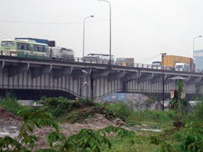
Southern bridge can collapse any time:
official
7-31-07
|
The 43-year-old Dong Nai Bridge in the eponymous
southern Vietnamese province, connecting three
industrial hubs including Ho Chi Minh City, can collapse
any time, an official has warned.
Colonel Nguyen Phi Hung, provincial deputy police chief,
speaking at a conference Monday, blamed it on the
increasing traffic which was overloading the bridge.
He had
warned the Ministry of Transport several times but it
had said the bridge “had seriously degraded but cannot
collapse”.
Tran
Van Quan, deputy director of the province’s transport
department, told the conference that it was not until
recently when the local administration had directly
pleaded with Minister of Transport Ho Nghia Dung that he
had instructed a state-owned company to do a feasibility
study for a new bridge.
The
bridge links Dong Nai and Binh Duong
|
|
|
|
Vital Cayuga County bridge
collapses
New York State
Posted 7-31-07

By: Evan Axelbank
CAYUGA COUNTY, N.Y. -- Now
that pieces of this deteriorating bridge are lying
in the water, the people who rely on it to cross
the Seneca River, hope a turning point is here.
"You're really, really mad, and
yet you're excited at the same time, that it
finally did collapse again, for the second time,
and maybe, now they will do something about it,"
said Tonya Anelli, a Haiti Island resident.
Bridge gives out
Parts of a bridge in Cayuga County
collapsed early Saturday morning. The
bridge connects the town of Mentz to Haiti
Island. No one was hurt in the collapse,
but for the 60 people who live on the
Island, the bridge is a matter of
survival. Ironically, just last week, the
town held a meeting with state and elected
officials to talk about how to fix the
bridge. But the bridge collapsed before a
plan could be put into motion. News 10
Now's Evan Axelbank explains.
"You can't get groceries, no
fuel trucks can get across, no water delivery can
be delivered, we're just basically all stranded," Anelli said.
The bridge is a 25 foot-long
lifeline for an island that's not connected to
municipal gas, water or sewer. The part that
collapsed is from an old bridge, which is now
covered by the newer main deck. For now, residents
were allowed one trip to bring cars to the
mainland, but will need to carry supplies on foot
or by boat.
"It's not bad right now because
it's summer time, but if this goes until winter,
then you have the ice and a real big problem,"
said resident Betty Ranger.
The town of Mentz admits it has
no solution on its own. Fixing the bridge isn't
possible on their budget. For now, the state will
send a team to inspect it to figure out if cars
can begin to travel the bridge again.
"Our bridge inspectors will look
at the structural elements, look at the condition
of the deck and the substructure and make that
determination," said Anthony Ilacqua, a State DOT
spokesman.
But even if the state decides
it's safe for cars, residents hope the bridge's
latest collapse will be proof enough that it's
time for higher levels of government to foot the
bill for a new bridge, the only way to get to
Haiti Island.
|
|
|
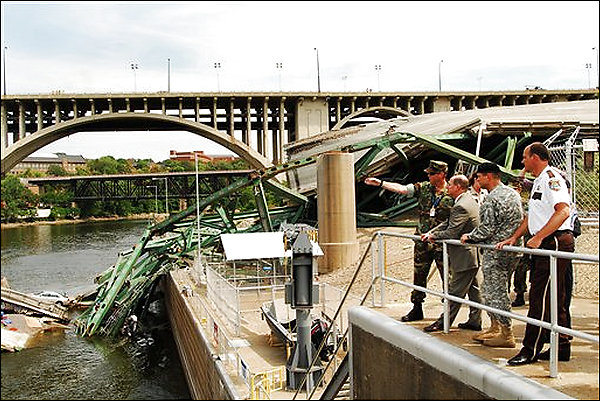 This photo made available by the Navy Visual News Service shows Secretary of the Navy Donald C. Winter, 2nd left, as he tours the site of the I-35 bridge collapse over the Mississippi river with Department of Defense, federal, state, and local officials in Minneapolis, Wednesday, Aug. 8, 2007.
This photo made available by the Navy Visual News Service shows Secretary of the Navy Donald C. Winter, 2nd left, as he tours the site of the I-35 bridge collapse over the Mississippi river with Department of Defense, federal, state, and local officials in Minneapolis, Wednesday, Aug. 8, 2007. 
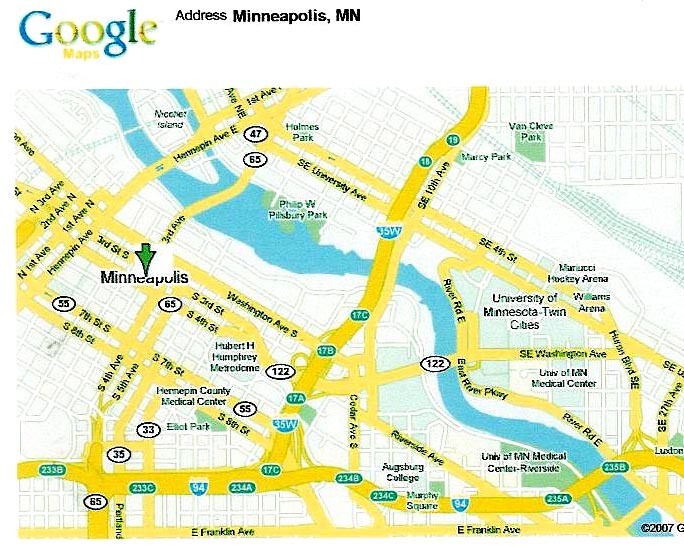
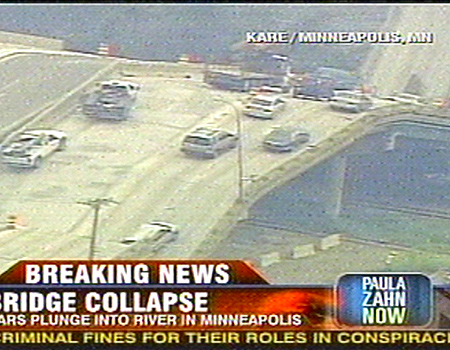
 .
.

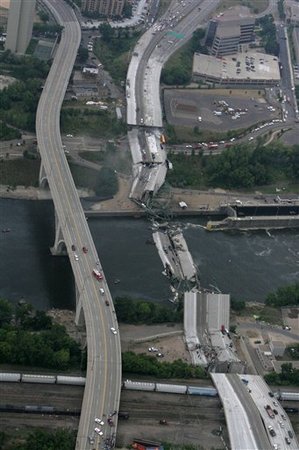
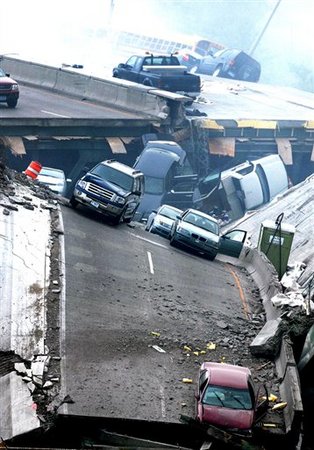
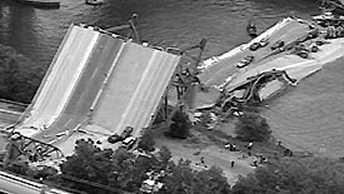
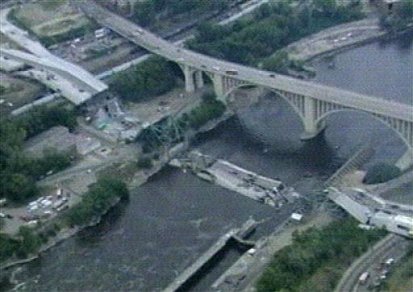
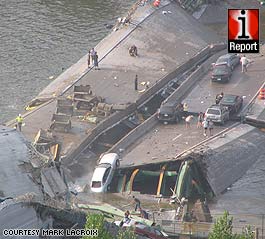

 Slideshow: I-35W Bridge Collapse
Slideshow: I-35W Bridge Collapse